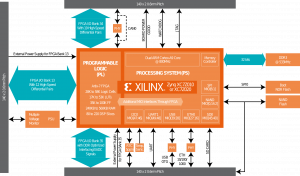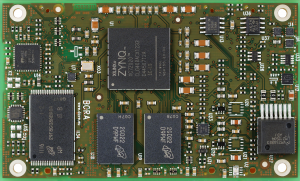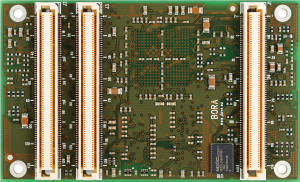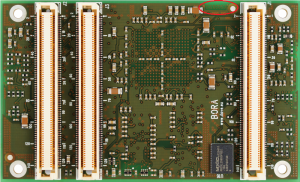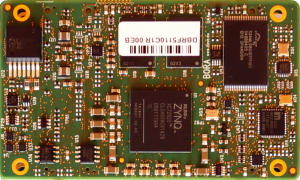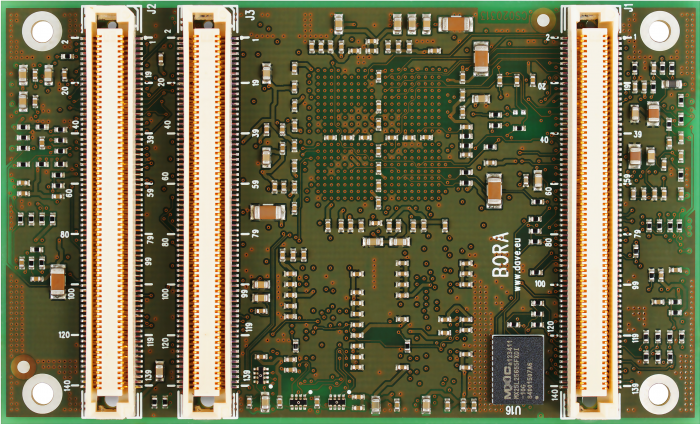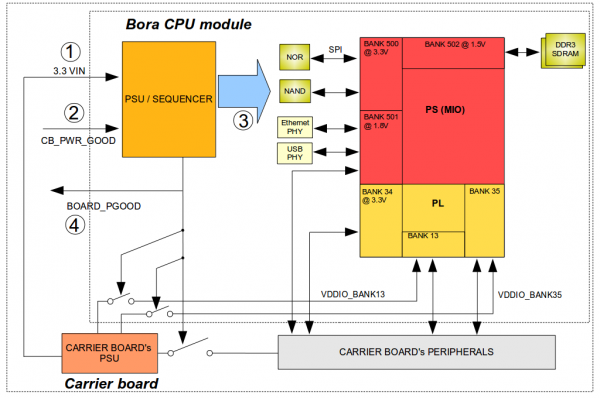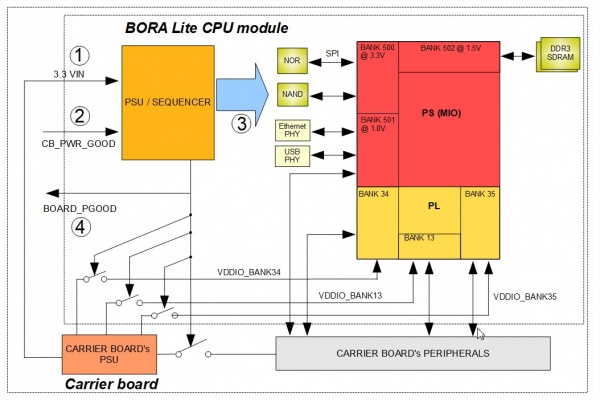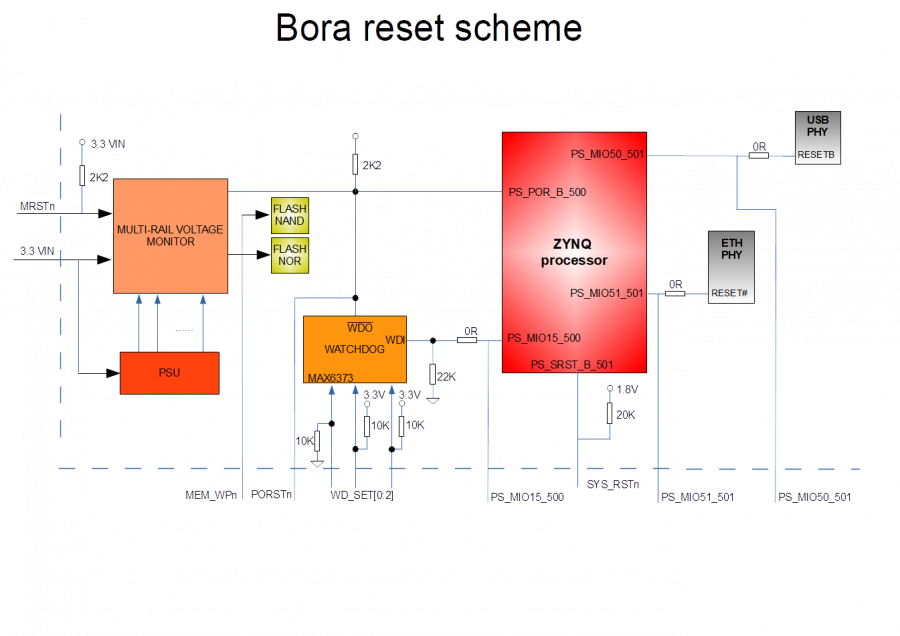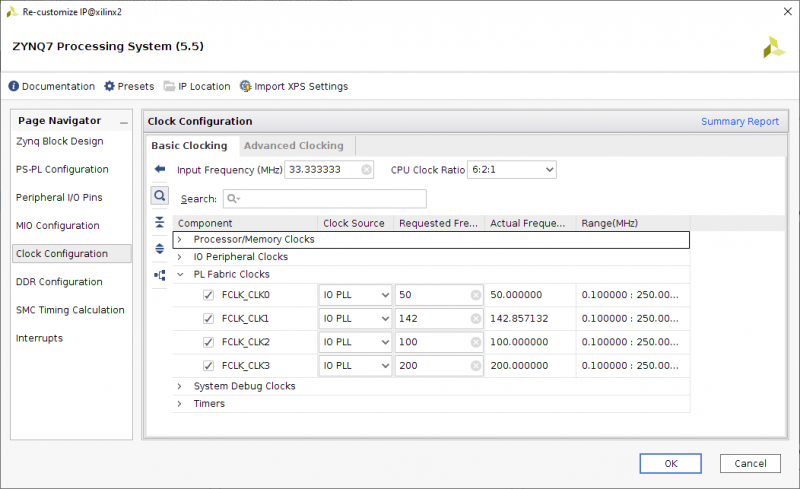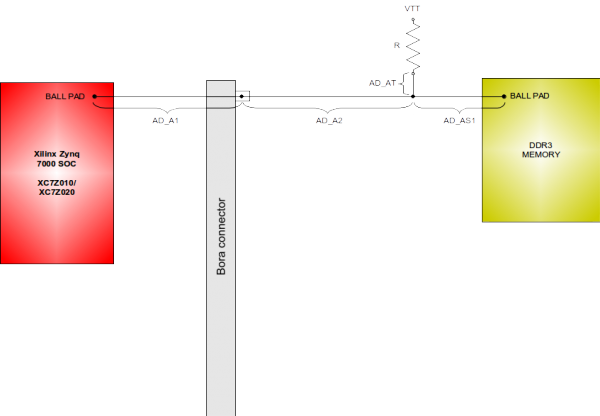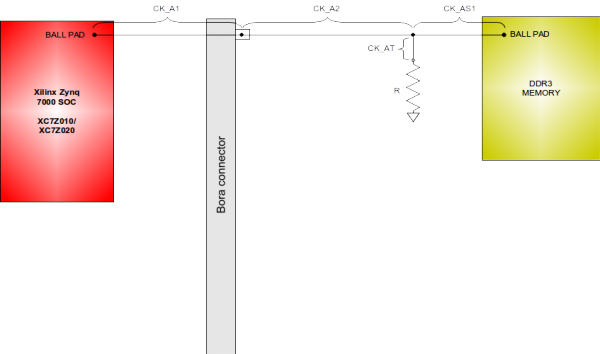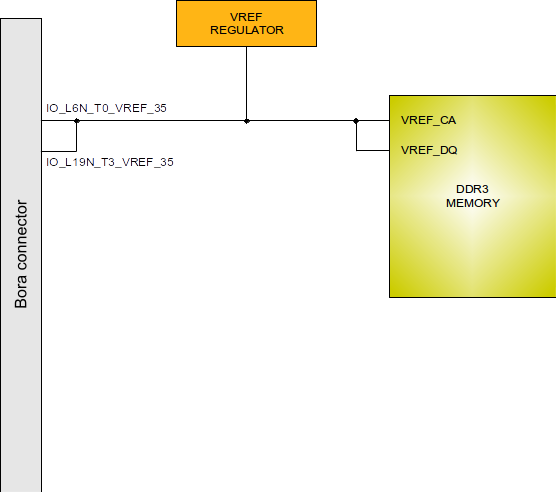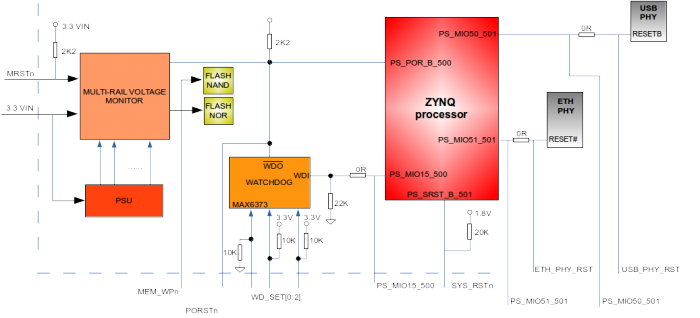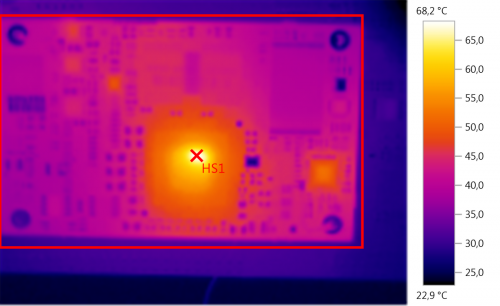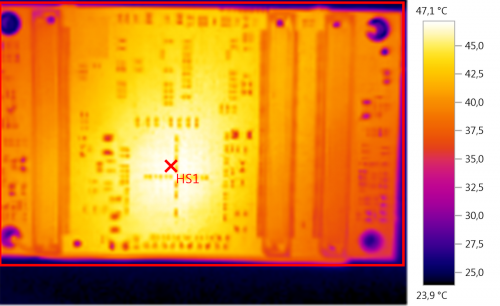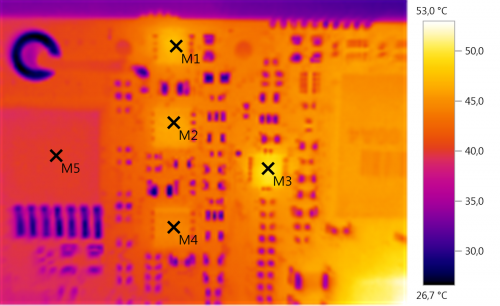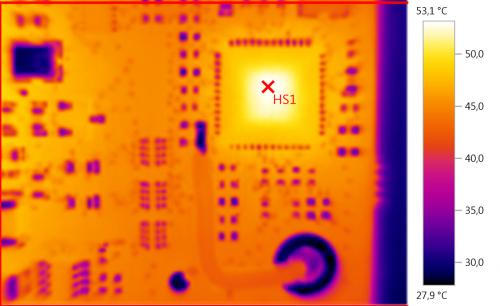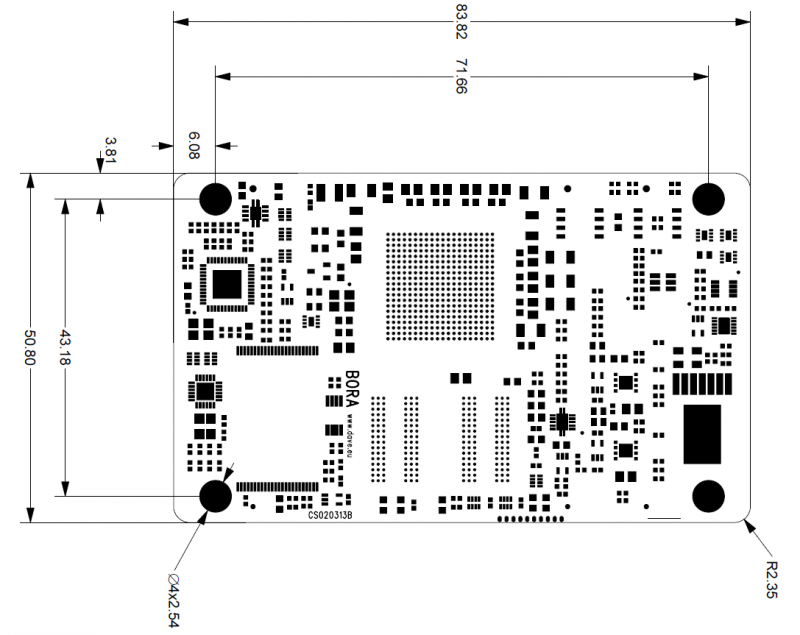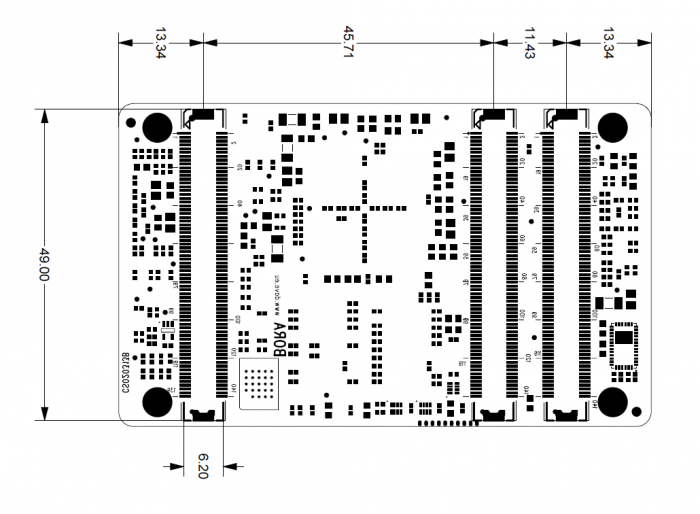BORA SOM/BORA Hardware/pdf
General Information[edit | edit source]
BORA Block Diagram[edit | edit source]
BORA TOP View[edit | edit source]
BORA BOTTOM View[edit | edit source]
Processor and memory subsystem[edit | edit source]
The heart of Bora module is composed of the following components:
- Xilinx Zynq Z-7010 (XC7Z010) / Z-7020 (XC7Z020) SoC
- Power supply unit
- DDR memory banks
- NOR and NAND flash banks
- 3x 140 pin connectors with interfaces signals
This chapter shortly describes the main Bora components.
Processor Info[edit | edit source]
The Zynq™-7000 family is based on the Xilinx Extensible Processing Platform (EPP) architecture. These products integrate a feature-rich dual-core ARM® Cortex™-A9 based processing system (PS) and 28 nm Xilinx programmable logic (PL) in a single device. The ARM Cortex-A9 CPUs are the heart of the PS and also include on-chip memory, external memory interfaces, and a rich set of peripheral connectivity interfaces. The Zynq-7000 family offers the flexibility and scalability of an FPGA, while providing performance, power, and ease of use typically associated with ASIC and ASSPs. The range of devices in the Zynq-7000 AP SoC family enables designers to target cost-sensitive as well as high-performance applications from a single platform using industry-standard tools. While each device in the Zynq-7000 family contains the same PS, the PL and I/O resources vary between the devices. As a result, the Zynq-7000 AP SoC devices are able to serve a wide range of applications including:
- Automotive driver assistance, driver information, and infotainment
- Broadcast camera
- Industrial motor control, industrial networking, and machine vision
- IP and Smart camera
- LTE radio and baseband
- Medical diagnostics and imaging
- Multifunction printers
- Video and night vision equipment
The processors in the PS always boot first, allowing a software centric approach for PL system boot and PL configuration. The PL can be configured as part of the boot process or configured at some point in the future. Additionally, the PL can be completely reconfigured or used with partial, dynamic reconfiguration (PR). PR allows configuration of a portion of the PL. This enables optional design changes such as updating coefficients or time-multiplexing of the PL resources by swapping in new algorithms as needed.
Bora can mount two versions of the Zynq processor. The following table shows a comparison between the processor models, highlighting the differences:
| Processor | Programmable logic cells | LUTs | Flip flops | Extensible block RAM | DSP slices | Peak DSP performance |
| XC7Z010 | 28K Logic Cells | 17600 | 35200 | 240 KB | 80 | 58 GMACs |
| XC7Z020 | 85K Logic Cells | 53200 | 106400 | 560 KB | 220 | 158 GMACs |
On PS side, the following peripherals and devices are connected to MIO signals:
- Serial NOR fl ash (MIO [6:1])
- NAND fl ash (MIO [0], [14:2])
- UART1 (MIO [49:48])
- I2C temperature sensor (MIO [47:46])
- I2C MEMS RTC (MIO [47:46])
- Gigabit Ethernet PHY (MIO [27:16])
- USBOTG PHY (MIO [39:28])
- SD/MMC (MIO [45:40])
Since these devices are considered essential, they have been connected to MIO signals in order to make them always functional, even if PL is not programmed. These peripherals represent the default configuration for the BORA SOM, but other configurations can be implemented changing the pin multiplexing
RAM memory bank[edit | edit source]
DDR3 SDRAM memory bank is composed by 2x 16-bit width chips resulting in a 32-bit combined width bank. The following table reports the SDRAM specifications:
| CPU connection | SDRAM bus |
| Size min | 512 MB |
| Size max | 1 GB |
| Width | 32 bit |
| Speed | 533 MHz |
NOR flash bank[edit | edit source]
NOR flash is a Serial Peripheral Interface (SPI) device. By default this device is connected to SPI channel 0 and acts as boot memory. The following table reports the NOR flash specifications:
| CPU connection | SPI Channel 0 |
| Size min | 8 MB |
| Size max | 16 MB - This limitation is due to this Errata from Xilinx. The proposed solution by Xilinx has not been approved by DAVE Embedded Systems |
| Chip select | SPI_CS0n |
| Bootable | Yes |
NAND flash bank[edit | edit source]
On board main storage memory is a 8-bit wide NAND flash. By default it is connected to chip select. The following table reports the NAND flash specifications:
| CPU connection | Static memory controller |
| Page size | 512 byte, 2 kbyte or 4 kbyte |
| Size min | 128 MB |
| Size max | 1 GB |
| Width | 8 bit |
| Chip select | NAND_CS0 |
| Bootable | Yes |
Integrated FPGA[edit | edit source]
The PL is derived from Xilinx’s 7 Series FPGA technology (Artix™-7 for the 7z010/7z020). The PL is used to extend the functionality to meet specific application requirements. The PL provides many different types of resources including configurable logic blocks (CLBs), port and width configurable block RAM (BRAM), DSP slices with 25 x 18 multiplier, 48-bit accumulator and pre-adder (DSP48E1), a user configurable analog to digital converter (XADC), clock management tiles (CMT), a configuration block with 256b AES for decryption and SHA for authentication, configurable I/Os (with differential signaling capabilities). BORA customers are able to differentiate their product in hardware by customizing their applications using PL.
PL subsystem provides a lot of configurable I/Os, grouped in banks denoted as Bank x (eg Bank 9, Bank 13 etc.). Two types of such banks exist: HR 1 and HP 2. Some of the MIO signals can be routed outside the component via PL subsystem. This technique is called EMIO routing.
Power supply unit[edit | edit source]
Bora, as the other Ultra Line CPU modules, embeds all the elements required for powering the unit, therefore power sequencing is self-contained and simplified. Nevertheless, power must be provided from carrier board, and therefore users should be aware of the ranges power supply can assume as well as all other parameters. For detailed information, please refer to Power Supply Unit page.
CPU module connectors[edit | edit source]
All interface signals Bora provides are routed through three 140 pin 0.6mm pitch stacking connectors (named J1, J2 and J3). The dedicated carrier board must mount the mating connectors and connect the desired peripheral interfaces according to Bora pinout specifications.
Hardware versioning and tracking[edit | edit source]
BORA SOM implements well established versioning and tracking mechanisms:
- PCB version is copper printed on PCB itself, as shown in Fig. 1
- serial number: it is printed on a white label, as shown in Fig. 2: see also Product serial number page for more details
- ConfigID: it is used by software running on the board for the identification of the product model/hardware configuration. For more details, please refer to this link
- On BORA SOM ConfigID is stored in these areas of NOR SPI OTP
Part number composition[edit | edit source]
BORA SOM module part number is identified by the following digit-code table:
| Part number structure | Options | Description |
|---|---|---|
| Family | DBR | Family prefix code |
| SOC |
|
System on chip definition (and FPGA speed grade) |
| NOR SPI |
|
QUAD SPI NOR flash memory size - The limitation to max 16MB is due to this Errata from Xilinx. The proposed solution by Xilinx has not been approved by DAVE Embedded Systems |
| RAM |
|
DDR3 Memory RAM size |
| NAND |
|
Flash memory NAND size |
| Boot/Misc |
|
Boot and Voltage Monitor options |
| Temperature range |
|
|
| PCB revision |
|
PCB release may change for manufacturing purposes (i.e. text fixture adaptation) |
| Manufacturing option |
|
typically connected to production process and quality |
| Software Configuration | -00: standard factory u-boot pre-programmed
-XX: custom version |
If customers require custom SW deployed this section should be defined and agreed. Please contact technical support |
Example[edit | edit source]
BORA SOM code DBRF4110C2R-00
- DBR - BORA SOM module
- F - XC7Z020 ARM Cortex-A9 866MHz - Speed grade -3
- 4 - 16MB NOR Flash
- 1 - 1GB DDR3
- 1 - 1GB NAND flash
- 0 - NOR boot, FPGA bank 34 fixed PSU, without Voltage monitor
- C - Commercial temperature range
- 2 - PCB revision C
- R- RoHS manufacturing process
- -00 - standard u-boot pre-programmed
Pinout Table[edit | edit source]
Connectors and Pinout Table[edit | edit source]
This chapter contains the pinout description of the Bora module, grouped in six tables (two – odd and even pins – for each connector) that report the pin mapping of the three 140-pin Bora connectors.
Connectors description[edit | edit source]
In the following table are described the interface connectors on Bora SOM:
| Connector name | Connector Type | Notes | Carrier board counterpart |
|---|---|---|---|
| J1, J2, J3 | Hirose FX8C-140S-SV 3x140 pins 0.6mm pitch connectors |
Hirose FX8C-140P-SV<x>
where <x> stays for:
|
The dedicated carrier board must mount the mating connector and connect the desired peripheral interfaces according to BORA pinout specifications. See the images below for reference:
Pinout table naming conventions[edit | edit source]
Each row in the pinout tables contains the following information:
| Pin | Reference to the connector pin |
| Pin Name | Pin (signal) name on the AxelLite connectors |
| Internal connections |
Connections to the components
|
| Ball/pin # | Component ball/pin number connected to signal |
| Voltage | I/O voltage levels
|
| Type | Pin type:
|
| Notes | Remarks on special pin characteristics |
SOM J1 ODD pins (1 to 139) declaration[edit | edit source]
| Pin | Pin Name | Internal Connections | Ball/pin # | Supply Group | Type | Voltage | Note |
| J1.1 | DGND | DGND | - | G | |||
| J1.3 | IO_L7P_T1_AD2P_35 | FPGA.IO_L7P_T1_AD2P_35 | M19 | BANK35 | I/O | U.D. | |
| J1.5 | IO_L10P_T1_AD11P_35 | FPGA.IO_L10P_T1_AD11P_35 | K19 | BANK35 | I/O | U.D. | |
| J1.7 | IO_L11P_T1_SRCC_35 | FPGA.IO_L11P_T1_SRCC_35 | L16 | BANK35 | I/O | U.D. | |
| J1.9 | IO_L8N_T1_AD10N_35 | FPGA.IO_L8N_T1_AD10N_35 | M18 | BANK35 | I/O | U.D. | |
| J1.11 | IO_L7N_T1_AD2N_35 | FPGA.IO_L7N_T1_AD2N_35 | M20 | BANK35 | I/O | U.D. | |
| J1.13 | DGND | DGND | - | G | |||
| J1.15 | IO_L9P_T1_DQS_AD3P_35 | FPGA.IO_L9P_T1_DQS_AD3P_35 | L19 | BANK35 | I/O | U.D. | |
| J1.17 | IO_L9N_T1_DQS_AD3N_35 | FPGA.IO_L9N_T1_DQS_AD3N_35 | L20 | BANK35 | I/O | U.D. | |
| J1.19 | DGND | DGND | - | G | |||
| J1.21 | IO_L20P_T3_AD6P_35 | FPGA.IO_L20P_T3_AD6P_35 | K14 | BANK35 | I/O | U.D. | |
| J1.23 | IO_L20N_T3_AD6N_35 | FPGA.IO_L20N_T3_AD6N_35 | J14 | BANK35 | I/O | U.D. | |
| J1.25 | IO_L22P_T3_AD7P_35 | FPGA.IO_L22P_T3_AD7P_35 | L14 | BANK35 | I/O | U.D. | |
| J1.27 | IO_L12N_T1_MRCC_35 | FPGA.IO_L12N_T1_MRCC_35 | K18 | BANK35 | I/O | U.D. | |
| J1.29 | DGND | DGND | - | G | |||
| J1.31 | IO_L21P_T3_DQS_AD14P_35 | FPGA.IO_L21P_T3_DQS_AD14P_35 | N15 | BANK35 | I/O | U.D. | |
| J1.33 | IO_L21N_T3_DQS_AD14N_35 | FPGA.IO_L21N_T3_DQS_AD14N_35 | N16 | BANK35 | I/O | U.D. | |
| J1.35 | DGND | DGND | - | G | |||
| J1.37 | IO_L17N_T2_AD5N_35 | FPGA.IO_L17N_T2_AD5N_35 | H20 | BANK35 | I/O | U.D. | |
| J1.39 | IO_L13N_T2_MRCC_35 | FPGA.IO_L13N_T2_MRCC_35 | H17 | BANK35 | I/O | U.D. | |
| J1.41 | IO_L19P_T3_35 | FPGA.IO_L19P_T3_35 | H15 | BANK35 | I/O | U.D. | |
| J1.43 | IO_L18P_T2_AD13P_35 | FPGA.IO_L18P_T2_AD13P_35 | G19 | BANK35 | I/O | U.D. | |
| J1.45 | IO_L16P_T2_35 | FPGA.IO_L16P_T2_35 | G17 | BANK35 | I/O | ||
| J1.47 | IO_L15N_T2_DQS_AD12N_35 | FPGA.IO_L15N_T2_DQS_AD12N_35 | F20 | BANK35 | I/O | U.D. | |
| J1.49 | DGND | DGND | - | G | |||
| J1.51 | IO_L2N_T0_AD8N_35 | FPGA.IO_L2N_T0_AD8N_35 | A20 | BANK35 | I/O | U.D. | |
| J1.53 | IO_L1N_T0_AD0N_35 | FPGA.IO_L1N_T0_AD0N_35 | B20 | BANK35 | I/O | U.D. | |
| J1.55 | IO_L5N_T0_AD9N_35 | FPGA.IO_L5N_T0_AD9N_35 | E19 | BANK35 | I/O | U.D. | |
| J1.57 | IO_L5P_T0_AD9P_35 | FPGA.IO_L5P_T0_AD9P_35 | E18 | BANK35 | I/O | U.D. | |
| J1.59 | DGND | DGND | - | G | |||
| J1.61 | IO_L3P_T0_DQS_AD1P_35 | FPGA.IO_L3P_T0_DQS_AD1P_35 | E17 | BANK35 | I/O | U.D. | |
| J1.63 | IO_L3N_T0_DQS_AD1N_35 | FPGA.IO_L3N_T0_DQS_AD1N_35 | D18 | BANK35 | I/O | U.D. | |
| J1.65 | DGND | DGND | - | G | |||
| J1.67 | VDDIO_BANK35 | FPGA.VCCO_35 | C19 F18 H14 J17 K20 M16 |
BANK35 | S | User Defined: 1.8V to 3.3V (see Programmable logic (Bora) ) | |
| J1.69 | XADC_AGND | FPGA.GNDADC_0 | J10 | A / G | |||
| J1.71 | XADC_AGND | FPGA.GNDADC_0 | J10 | A / G | |||
| J1.73 | PS_MIO45_501 | CPU.PS_MIO45_501 | B15 | BANK501 | I/O | 1.8V | |
| J1.75 | PS_MIO44_501 | CPU.PS_MIO44_501 | F13 | BANK501 | I/O | 1.8V | |
| J1.77 | PS_MIO43_501 | CPU.PS_MIO43_501 | A9 | BANK501 | I/O | 1.8V | |
| J1.79 | PS_MIO42_501 | CPU.PS_MIO42_501 | E12 | BANK501 | I/O | 1.8V | |
| J1.81 | PS_MIO41_501 | CPU.PS_MIO41_501 | C17 | BANK501 | I/O | 1.8V | |
| J1.83 | DGND | DGND | - | G | |||
| J1.85 | PS_MIO40_501 | CPU.PS_MIO40_501 | D14 | BANK501 | I/O | 1.8V | |
| J1.87 | ETH_MDIO | CPU.PS_MIO53_501 LAN.MDIO |
C11 37 |
BANK501 | I/O | 1.8V | |
| J1.89 | ETH_MDC | CPU.PS_MIO12_501 LAN.MDC |
C10 36 |
BANK501 | I/O | 1.8V | |
| J1.91 | ETH_LED1 | LAN.LED1 / PME_N1 | 17 | I/O | 1.8V | Internal 10K pull-up to DVDDH (i.e. PHYAD0 = 1) . Level translator needed if used @ 3V3 | |
| J1.93 | ETH_LED2 | LAN.LED2 | 15 | I/O | 1.8V | Internal 10K pull-up to DVDDH (i.e. PHYAD1 = 1) . Level translator needed if used @ 3V3 | |
| J1.95 | DGND | DGND | - | G | |||
| J1.97 | ETH_TXRX1_M | LAN.TXRXM_B | 6 | D | 3.3V | ||
| J1.99 | ETH_TXRX1_P | LAN.TXRXP_B | 5 | D | 3.3V | ||
| J1.101 | DGND | DGND | - | G | |||
| J1.103 | ETH_TXRX0_M | LAN.TXRXM_A | 3 | D | 3.3V | ||
| J1.105 | ETH_TXRX0_P | LAN.TXRXP_A | 2 | D | 3.3V | ||
| J1.107 | D.N.C | - | Do Not Connect (reserved for internal use) | ||||
| J1.109 | N.C. | Not Connected | - | ||||
| J1.111 | USBOTG_CPEN | USB.CPEN | 7 | O | 1.8V | External 5V suply enable. For further details, please refer to the Microchip USB3317 datasheet. | |
| J1.113 | OTG_VBUS | USB.OTG_VBUS | 2 | I/O | 5V | USB VBUS comparator. For further details, please refer to the Microchip USB3317 datasheet. | |
| J1.115 | OTG_ID | USB.ID | 1 | I | 5V | ID of the USB cable. For further details, please refer to the Microchip USB3317 datasheet. | |
| J1.117 | DGND | DGND | - | G | |||
| J1.119 | SPI0_DQ3/MODE0/NAND_IO0 | CPU.PS_MIO5_500 | A6 | BANK500 | I/O | 3.3V | Internally connected as NAND I/O (if populated)
This signal is internally pulled up or down by 20kOhm resistor depending on order code (selecting then the bootstrap configuration) |
| J1.121 | SPI0_DQ2/MODE2/NAND_IO2 | CPU.PS_MIO4_500 | B7 | BANK500 | I/O | 3.3V | Internally connected as NAND I/O (if populated)
This signal is internally pulled up or down by 20kOhm resistor depending on order code (selecting then the bootstrap configuration) |
| J1.123 | SPI0_DQ1/MODE1/NAND_WE | CPU.PS_MIO3_500 | D6 | BANK500 | I/O | 3.3V | Internally connected as NAND I/O (if populated)
This signal is internally pulled up or down by 20kOhm resistor depending on order code (selecting then the bootstrap configuration) |
| J1.125 | SPI0_DQ0/MODE3/NAND_ALE | CPU.PS_MIO2_500 | B8 | BANK500 | I/O | 3.3V | Internally connected as NAND I/O (if populated)
This signal is internally pulled up or down by 20kOhm resistor depending on order code (selecting then the bootstrap configuration) |
| J1.127 | DGND | DGND | - | G | |||
| J1.129 | SPI0_SCLK/MODE4/NAND_IO1 | CPU.PS_MIO6_500 | A5 | BANK500 | I/O | 3.3V | Internally connected as NAND I/O (if populated)
This signal is internally pulled up or down by 20kOhm resistor depending on order code (selecting then the bootstrap configuration) |
| J1.131 | NAND_BUSY | CPU.PS_MIO14_500 | C5 | BANK500 | I/O | 3.3V | Internally connected as NAND I/O (if populated) |
| J1.133 | PS_MIO15_500 | CPU.PS_MIO15_500 WDT.WDI |
C8 1 |
BANK500 | I/O | 3.3V | See also this page |
| J1.135 | N.C. | Not Connected | - | ||||
| J1.137 | MEM_WPN | NAND.WP - NOR.WP/IO2 | 19 - C4 | I/O | Internally connected to NAND and NOR WP | ||
| J1.139 | DGND | DGND | - | G |
SOM J1 EVEN pins (2 to 140) declaration[edit | edit source]
| Pin | Pin Name | Internal Connections | Ball/pin # | Supply Group | Type | Voltage | Note |
| J1.2 | VDDIO_BANK35 | FPGA.VCCO_35 | C19 F18 H14 J17 K20 M16 |
BANK35 | S | User Defined: 1.8V to 3.3V (see Programmable logic (Bora) ) | |
| J1.4 | DGND | DGND | - | G | |||
| J1.6 | IO_L10N_T1_AD11N_35 | FPGA.IO_L10N_T1_AD11N_35 | J19 | BANK35 | I/O | U.D. | |
| J1.8 | IO_L12P_T1_MRCC_35 | FPGA.IO_L12P_T1_MRCC_35 | K17 | BANK35 | I/O | U.D. | |
| J1.10 | IO_L11N_T1_SRCC_35 | FPGA.IO_L11N_T1_SRCC_35 | L17 | BANK35 | I/O | U.D. | |
| J1.12 | IO_L8P_T1_AD10P_35 | FPGA.IO_L8P_T1_AD10P_35 | M17 | BANK35 | I/O | U.D. | |
| J1.14 | DGND | DGND | - | G | |||
| J1.16 | IO_L24N_T3_AD15N_35 | FPGA.IO_L24N_T3_AD15N_35 | J16 | BANK35 | I/O | U.D. | |
| J1.18 | IO_25_35 | FPGA.IO_25_35 | J15 | BANK35 | I/O | U.D. | |
| J1.20 | IO_L24P_T3_AD15P_35 | FPGA.IO_L24P_T3_AD15P_35 | K16 | BANK35 | I/O | U.D. | |
| J1.22 | IO_L23N_T3_35 | FPGA.IO_L23N_T3_35 | M15 | BANK35 | I/O | U.D. | |
| J1.24 | DGND | DGND | - | G | |||
| J1.26 | IO_L22N_T3_AD7N_35 | FPGA.IO_L22N_T3_AD7N_35 | L15 | BANK35 | I/O | U.D. | |
| J1.28 | IO_L23P_T3_35 | FPGA.IO_L23P_T3_35 | M14 | BANK35 | I/O | U.D. | |
| J1.30 | DGND | DGND | - | G | |||
| J1.32 | IO_L17P_T2_AD5P_35 | FPGA.IO_L17P_T2_AD5P_35 | J20 | BANK35 | I/O | U.D. | |
| J1.34 | IO_L14P_T2_AD4P_SRCC_35 | FPGA.IO_L14P_T2_AD4P_SRCC_35 | J18 | BANK35 | I/O | U.D. | |
| J1.36 | IO_L14N_T2_AD4N_SRCC_35 | FPGA.IO_L14N_T2_AD4N_SRCC_35 | H18 | BANK35 | I/O | U.D. | |
| J1.38 | DGND | DGND | - | G | |||
| J1.40 | IO_L13P_T2_MRCC_35 | FPGA.IO_L13P_T2_MRCC_35 | H16 | BANK35 | I/O | U.D. | |
| J1.42 | IO_L18N_T2_AD13N_35 | FPGA.IO_L18N_T2_AD13N_35 | G20 | BANK35 | I/O | U.D. | |
| J1.44 | IO_L16N_T2_35 | FPGA.IO_L16N_T2_35 | G18 | BANK35 | I/O | U.D. | |
| J1.46 | IO_L15P_T2_DQS_AD12P_35 | FPGA.IO_L15P_T2_DQS_AD12P_35 | F19 | BANK35 | I/O | U.D. | |
| J1.48 | DGND | DGND | - | G | |||
| J1.50 | IO_L1P_T0_AD0P_35 | FPGA.IO_L1P_T0_AD0P_35 | C20 | BANK35 | I/O | U.D. | |
| J1.52 | IO_L2P_T0_AD8P_35 | FPGA.IO_L2P_T0_AD8P_35 | B19 | BANK35 | I/O | U.D. | |
| J1.54 | IO_L4N_T0_35 | FPGA.IO_L4N_T0_35 | D20 | BANK35 | I/O | U.D. | |
| J1.56 | IO_L4P_T0_35 | FPGA.IO_L4P_T0_35 | D19 | BANK35 | I/O | U.D. | |
| J1.58 | IO_L6P_T0_35 | FPGA.IO_L6P_T0_35 | F16 | BANK35 | I/O | U.D. | |
| J1.60 | DGND | DGND | - | G | |||
| J1.62 | IO_L6N_T0_VREF_35 | FPGA.IO_L6N_T0_VREF_35 | F17 | BANK35 | I/O | U.D. | |
| J1.64 | IO_L19N_T3_VREF_35 | FPGA.IO_L19N_T3_VREF_35 | G15 | BANK35 | I/O | U.D. | |
| J1.66 | VDDIO_BANK35 | FPGA.VCCO_35 | C19 F18 H14 J17 K20 M16 |
BANK35 | S | User Defined: 1.8V to 3.3V (see Programmable logic (Bora) ) | |
| J1.68 | VDDIO_BANK35 | FPGA.VCCO_35 | C19 F18 H14 J17 K20 M16 |
BANK35 | S | User Defined: 1.8V to 3.3V (see Programmable logic (Bora) ) | |
| J1.70 | XADC_AGND | FPGA.GNDADC_0 | J10 | A/G | |||
| J1.72 | XADC_AGND | FPGA.GNDADC_0 | J10 | A/G | |||
| J1.74 | IO_0_35 | FPGA.IO_0_35 | G14 | BANK35 | I/O | U.D. | |
| J1.76 | N.C. | Not Connected | - | ||||
| J1.78 | N.C. | Not Connected | - | ||||
| J1.80 | PS_MIO49_501 | CPU.PS_MIO49_501 | C12 | BANK501 | I/O | 1.8V | Configured as UART1_RX on BELK BSP |
| J1.82 | PS_MIO48_501 | CPU.PS_MIO48_501 | B12 | BANK501 | I/O | 1.8V | Configured as UART1_TX on BELK BSP |
| J1.84 | PS_MIO47_501 | CPU.PS_MIO47_501 | B14 | BANK501 | I/O | 1.8V | Internally connected as I2C0_SDA (10K pull-up) |
| J1.86 | DGND | DGND | - | G | |||
| J1.88 | PS_MIO46_501 | CPU.PS_MIO46_501 | D16 | BANK501 | I/O | 1.8V | Internally connected as I2C0_CLK (10K pull-up) |
| J1.90 | ETH_INTN | LAN.INT_N / PME_N2 | 38 | O | 1.8V | Internal pull-up 4K7 (by default not connected) | |
| J1.92 | DGND | DGND | - | G | |||
| J1.94 | ETH_TXRX3_M | LAN.TXRXM_D | 11 | D | 3.3V | ||
| J1.96 | ETH_TXRX3_P | LAN.TXRXP_D | 10 | D | 3.3V | ||
| J1.98 | DGND | DGND | - | G | |||
| J1.100 | ETH_TXRX2_M | LAN.TXRXM_C | 8 | D | 3.3V | ||
| J1.102 | ETH_TXRX2_P | LAN.TXRXP_C | 7 | D | 3.3V | ||
| J1.104 | DGND | DGND | - | G | |||
| J1.106 | CLK125_NDO | LAN.CLK125_NDO | 41 | I/O | 1.8V | ||
| J1.108 | N.C. | Not Connected | - | ||||
| J1.110 | N.C. | Not Connected | - | ||||
| J1.112 | DGND | DGND | - | G | |||
| J1.114 | USBP1 | USB.DP | 6 | D | |||
| J1.116 | USBM1 | USB.DM | 5 | D | |||
| J1.118 | DGND | DGND | - | G | |||
| J1.120 | SPI0_CS0N | CPU.PS_MIO1_500 NOR.CS# |
A7 C2 |
BANK500 | I/O | 3.3V | Internally connected as NOR chip select (if populated) |
| J1.122 | NAND_CS0/SPI0_CS1 | CPU.PS_MIO0_500 NAND.~CE |
E6 9 |
BANK500 | I/O | 3.3V | Internally connected as NAND chip select (if populated) |
| J1.124 | NAND_IO3 | CPU.PS_MIO13_500 NAND.I/O3 |
E8 32 |
BANK500 | I/O | 3.3V | Internally connected as NAND I/O (if populated) |
| J1.126 | NAND_IO4 | CPU.PS_MIO9_500 NAND.I/O4 |
B5 41 |
BANK500 | I/O | 3.3V | Internally connected as NAND I/O (if populated) |
| J1.128 | NAND_IO5 | CPU.PS_MIO10_500 NAND.I/O5 |
E9 42 |
BANK500 | I/O | 3.3V | Internally connected as NAND I/O (if populated) |
| J1.130 | DGND | DGND | - | G | |||
| J1.132 | NAND_IO6 | CPU.PS_MIO11_500 NAND.I/O6 |
C6 43 |
BANK500 | I/O | 3.3V | Internally connected as NAND I/O (if populated) |
| J1.134 | NAND_IO7 | CPU.PS_MIO12_500 NAND.I/O7 |
D9 44 |
BANK500 | I/O | 3.3V | Internally connected as NAND I/O (if populated) |
| J1.136 | NAND_RD_B/VCFG1 | CPU.PS_MIO8_500 NAND.~RE |
D5 8 |
BANK500 | I/O | 3.3V | This signal is internally pulled up or down by 20kOhm resistor depending on order code (selecting then the bootstrap configuration) |
| J1.138 | NAND_CLE/VCFG0 | CPU.PS_MIO7_500 NAND.CLE |
D8 16 |
BANK500 | I/O | 3.3V | This signal is internally pulled up or down by 20kOhm resistor depending on order code (selecting then the bootstrap configuration) |
| J1.140 | DGND | DGND | - | G |
SOM J2 ODD pins (1 to 139) declaration[edit | edit source]
| Pin | Pin Name | Internal Connections | Ball/pin # | Supply Group | Type | Voltage | Note |
| J2.1 | DGND | DGND | - | G | |||
| J2.3 | DGND | DGND | - | G | |||
| J2.5 | IO_L8P_T1_34 | FPGA.IO_L8P_T1_34 | W14 | BANK34 | I/O | 3.3V | |
| J2.7 | IO_L8N_T1_34 | FPGA.IO_L8N_T1_34 | Y14 | BANK34 | I/O | 3.3V | |
| J2.9 | IO_L6P_T0_34 | CAN.D FPGA.IO_L6P_T0_34 |
1 P14 |
BANK34 | I/O | 3.3V | By default used as CAN.TX with internal CAN PHY transceiver (mount option) |
| J2.11 | IO_L6N_T0_VREF_34 | FPGA.IO_L6N_T0_VREF_34 | R14 | BANK34 | I/O | 3.3V | |
| J2.13 | DGND | DGND | - | G | |||
| J2.15 | IO_L3P_T0_DQS_PUDC_B_34 | FPGA.IO_L3P_T0_DQS_PUDC_B_34 | U13 | BANK34 | I/O | 3.3V | Internal 10K resistor pull-up |
| J2.17 | IO_L3N_T0_DQS_34 | FPGA.IO_L3N_T0_DQS_34 | V13 | BANK34 | I/O | 3.3V | |
| J2.19 | IO_L2P_T0_34 | FPGA.IO_L2P_T0_34 | T12 | BANK34 | I/O | 3.3V | |
| J2.21 | IO_L2N_T0_34 | FPGA.IO_L2N_T0_34 | U12 | BANK34 | I/O | 3.3V | |
| J2.23 | DGND | DGND | - | G | |||
| J2.25 | IO_L22P_T3_34 | FPGA.IO_L22P_T3_34 | W18 | BANK34 | I/O | 3.3V | |
| J2.27 | IO_L22N_T3_34 | FPGA.IO_L22N_T3_34 | W19 | BANK34 | I/O | 3.3V | |
| J2.29 | IO_L21P_T3_DQS_34 | FPGA.IO_L21P_T3_DQS_34 | V17 | BANK34 | I/O | 3.3V | |
| J2.31 | IO_L21N_T3_DQS_34 | FPGA.IO_L21N_T3_DQS_34 | V18 | BANK34 | I/O | 3.3V | |
| J2.33 | DGND | DGND | - | G | |||
| J2.35 | IO_L19P_T3_34 | CAN.R FPGA.IO_L19P_T3_34 |
4 R16 |
BANK34 | I/O | 3.3V | By default used as CAN.RX with internal CAN PHY transceiver (mount option) |
| J2.37 | IO_L19N_T3_VREF_34 | FPGA.IO_L19N_T3_VREF_34 | R17 | BANK34 | I/O | 3.3V | |
| J2.39 | IO_L18P_T2_34 | FPGA.IO_L18P_T2_34 | V16 | BANK34 | I/O | 3.3V | |
| J2.41 | IO_L18N_T2_34 | FPGA.IO_L18N_T2_34 | W16 | BANK34 | I/O | 3.3V | |
| J2.43 | DGND | DGND | - | G | |||
| J2.45 | IO_L15P_T2_DQS_34 | FPGA.IO_L15P_T2_DQS_34 | T20 | BANK34 | I/O | 3.3V | |
| J2.47 | IO_L15N_T2_DQS_34 | FPGA.IO_L15N_T2_DQS_34 | U20 | BANK34 | I/O | 3.3V | |
| J2.49 | DGND | DGND | - | ||||
| J2.51 | IO_L13P_T1_MRCC_34 | FPGA.IO_L13P_T1_MRCC_34 | N18 | BANK34 | I/O | 3.3V | |
| J2.53 | IO_L13N_T1_MRCC_34 | FPGA.IO_L13N_T1_MRCC_34 | P19 | BANK34 | I/O | 3.3V | |
| J2.55 | DGND | DGND | - | ||||
| J2.57 | IO_L11P_T1_SRCC_34 | FPGA.IO_L11P_T1_SRCC_34 | U14 | BANK34 | I/O | 3.3V | |
| J2.59 | IO_L11N_T1_SRCC_34 | FPGA.IO_L11N_T1_SRCC_34 | U15 | BANK34 | I/O | 3.3V | |
| J2.61 | DGND | DGND | - | ||||
| J2.63 | IO_L10P_T1_34 | FPGA.IO_L10P_T1_34 | V15 | BANK34 | I/O | 3.3V | |
| J2.65 | IO_L10N_T1_34 | FPGA.IO_L10N_T1_34 | W15 | BANK34 | I/O | 3.3V | |
| J2.67 | IO_25_34 | FPGA.IO_25_34 | T19 | BANK34 | I/O | 3.3V | |
| J2.69 | IO_0_34 | FPGA.IO_0_34 | R19 | BANK34 | I/O | 3.3V | |
| J2.71 | DGND | DGND | - | G | |||
| J2.73 | N.C. | Not Connected | - | ||||
| J2.75 | N.C. | Not Connected | - | ||||
| J2.77 | N.C. | Not Connected | - | ||||
| J2.79 | N.C. | Not Connected | - | ||||
| J2.81 | N.C. | Not Connected | - | ||||
| J2.83 | N.C. | Not Connected | - | ||||
| J2.85 | N.C. | Not Connected | - | ||||
| J2.87 | N.C. | Not Connected | - | ||||
| J2.89 | N.C. | Not Connected | - | ||||
| J2.91 | N.C. | Not Connected | - | ||||
| J2.93 | RTC_32KHZ | RTC.32KHZ | 1 | O | 3.3V | It can be left open if not used. For further details, please refer to the Maxim Integrated DS3232 datasheet. | |
| J2.95 | RTC_RST | RTC.~RST | 4 | I/O | 3.3V | It can be left open if not used. For further details, please refer to the Maxim Integrated DS3232 datasheet. | |
| J2.97 | XADC_VN_R | FPGA.VN_0 | L10 | A / I | VREFP | See BELK-TN-012 Using XADC signal module | |
| J2.99 | XADC_VP_R | FPGA.VP_0 | K9 | A / I | VREFP | See BELK-TN-012 Using XADC signal module | |
| J2.101 | N.C. | Not Connected | - | ||||
| J2.103 | CONN_SPI_RSTn | NOR.~RESET/RFU | A4 | 3.3V | |||
| J2.105 | CAN_L | CAN.L | 6 | I/O | 3.3V | For further details, please refer to the Texas Instruments SN65HVD232 datasheet. | |
| J2.107 | CAN_H | CAN.H | 7 | I/O | 3.3V | For further details, please refer to the Texas Instruments SN65HVD232 datasheet. | |
| J2.109 | DGND | DGND | - | G | |||
| J2.111 | RTC_INT/SQW | RTC.RTC_INT/SQW | 3 | I/O | 3.3V | It can be left open if not used. When used, a proper pull-up resistor is required on the carrier board. For further details, please refer to the Maxim Integrated DS3232 datasheet. | |
| J2.113 | RTC_VBAT | RTC.VBAT | 6 | S | 3.0V | Connect to ground if not used. For further details, please refer to the Maxim Integrated DS3232 datasheet. | |
| J2.115 | VBAT | CPU.VCCBATT_0 | F11 | S | This pin is connected to the VCCBATT_0 (for the battery-backed RAM - BBRAM) pin of the Zynq SOC. For additional information, please refer to the Zynq datasheet and TRM. | ||
| J2.117 | DGND | DGND | - | G | |||
| J2.119 | 3.3VIN | +3.3 V | - | S | |||
| J2.121 | 3.3VIN | +3.3 V | - | S | |||
| J2.123 | 3.3VIN | +3.3 V | - | S | |||
| J2.125 | DGND | DGND | - | G | |||
| J2.127 | 3.3VIN | +3.3 V | - | S | |||
| J2.129 | 3.3VIN | +3.3 V | - | S | |||
| J2.131 | 3.3VIN | +3.3 V | - | S | |||
| J2.133 | 3.3VIN | +3.3 V | - | S | |||
| J2.135 | 3.3VIN | +3.3 V | - | S | |||
| J2.137 | 3.3VIN | +3.3 V | - | S | |||
| J2.139 | DGND | DGND | - | G |
SOM J2 EVEN pins (2 to 140) declaration[edit | edit source]
| Pin | Pin Name | Internal Connections | Ball/pin # | Supply Group | Type | Voltage | Note |
| J2.2 | DGND | DGND | - | G | |||
| J2.4 | IO_L9P_T1_DQS_34 | FPGA.IO_L9P_T1_DQS_34 | T16 | BANK34 | I/O | 3.3V | |
| J2.6 | IO_L9N_T1_DQS_34 | FPGA.IO_L9N_T1_DQS_34 | U17 | BANK34 | I/O | 3.3V | |
| J2.8 | IO_L7P_T1_34 | FPGA.IO_L7P_T1_34 | Y16 | BANK34 | I/O | 3.3V | |
| J2.10 | IO_L7N_T1_34 | FPGA.IO_L7N_T1_34 | Y17 | BANK34 | I/O | 3.3V | |
| J2.12 | DGND | DGND | - | G | |||
| J2.14 | IO_L5P_T0_34 | FPGA.IO_L5P_T0_34 | T14 | BANK34 | I/O | 3.3V | |
| J2.16 | IO_L5N_T0_34 | FPGA.IO_L5N_T0_34 | T15 | BANK34 | I/O | 3.3V | |
| J2.18 | IO_L4P_T0_34 | FPGA.IO_L4P_T0_34 | V12 | BANK34 | I/O | 3.3V | |
| J2.20 | IO_L4N_T0_34 | FPGA.IO_L4N_T0_34 | W13 | BANK34 | I/O | 3.3V | |
| J2.22 | DGND | DGND | - | G | |||
| J2.24 | IO_L24P_T3_34 | FPGA.IO_L24P_T3_34 | P15 | BANK34 | I/O | 3.3V | |
| J2.26 | IO_L24N_T3_34 | FPGA.IO_L24N_T3_34 | P16 | BANK34 | I/O | 3.3V | |
| J2.28 | IO_L23P_T3_34 | FPGA.IO_L23P_T3_34 | N17 | BANK34 | I/O | 3.3V | |
| J2.30 | IO_L23N_T3_34 | FPGA.IO_L23N_T3_34 | P18 | BANK34 | I/O | 3.3V | |
| J2.32 | DGND | DGND | - | G | |||
| J2.34 | IO_L20P_T3_34 | FPGA.IO_L20P_T3_34 | T17 | BANK34 | I/O | 3.3V | |
| J2.36 | IO_L20N_T3_34 | FPGA.IO_L20N_T3_34 | R18 | BANK34 | I/O | 3.3V | |
| J2.38 | IO_L1P_T0_34 | FPGA.IO_L1P_T0_34 | T11 | BANK34 | I/O | 3.3V | |
| J2.40 | IO_L1N_T0_34 | FPGA.IO_L1N_T0_34 | T10 | BANK34 | I/O | 3.3V | |
| J2.42 | DGND | DGND | - | G | |||
| J2.44 | IO_L17P_T2_34 | FPGA.IO_L17P_T2_34 | Y18 | BANK34 | I/O | 3.3V | |
| J2.46 | IO_L17N_T2_34 | FPGA.IO_L17N_T2_34 | Y19 | BANK34 | I/O | 3.3V | |
| J2.48 | IO_L16P_T2_34 | FPGA.IO_L16P_T2_34 | V20 | BANK34 | I/O | 3.3V | |
| J2.50 | IO_L16N_T2_34 | FPGA.IO_L16N_T2_34 | W20 | BANK34 | I/O | 3.3V | |
| J2.52 | DGND | DGND | - | G | |||
| J2.54 | IO_L14P_T2_SRCC_34 | FPGA.IO_L14P_T2_SRCC_34 | N20 | BANK34 | I/O | 3.3V | |
| J2.56 | IO_L14N_T2_SRCC_34 | FPGA.IO_L14N_T2_SRCC_34 | P20 | BANK34 | I/O | 3.3V | |
| J2.58 | DGND | DGND | - | G | |||
| J2.60 | IO_L12P_T1_MRCC_34 | FPGA.IO_L12P_T1_MRCC_34 | U18 | BANK34 | I/O | 3.3V | |
| J2.62 | IO_L12N_T1_MRCC_34 | FPGA.IO_L12N_T1_MRCC_34 | U19 | BANK34 | I/O | 3.3V | |
| J2.64 | DGND | DGND | - | G | |||
| J2.66 | VDDIO_BANK34 | FPGA.VCCO_34 | N19 R15 T18 V14 W17 Y20 |
BANK34 | S | Mounting option (please contact sales dept. for more information) | |
| J2.68 | VDDIO_BANK34 | FPGA.VCCO_34 | N19 R15 T18 V14 W17 Y20 |
BANK34 | S | Mounting option (please contact sales dept. for more information) | |
| J2.70 | VDDIO_BANK34 | FPGA.VCCO_34 | N19 R15 T18 V14 W17 Y20 |
BANK34 | S | Mounting option (please contact sales dept. for more information) | |
| J2.72 | VDDIO_BANK34 | FPGA.VCCO_34 | N19 R15 T18 V14 W17 Y20 |
BANK34 | S | Mounting option (please contact sales dept. for more information) | |
| J2.74 | N.C. | Not Connected | - | ||||
| J2.76 | N.C. | Not Connected | - | ||||
| J2.78 | N.C. | Not Connected | - | ||||
| J2.80 | JTAG_TDO | CPU.TDO_0 | F6 | ||||
| J2.82 | JTAG_TDI | CPU.TDI_0 | G6 | ||||
| J2.84 | JTAG_TMS | CPU.TMS_0 | J6 | ||||
| J2.86 | JTAG_TCK | CPU.TCK_0 | F9 | ||||
| J2.88 | DGND | DGND | - | G | |||
| J2.90 | FPGA_INIT_B | FPGA.INIT_B_0 | R10 | For further details, please refer to PL initialization signals | |||
| J2.92 | FPGA_PROGRAM_B | FPGA.PROGRAM_B_0 | L6 | For further details, please refer to PL initialization signals
(10 kΩ pull-up resistor is already mounted on BORA module) | |||
| J2.94 | FPGA_DONE | FPGA.DONE_0 | R11 | For further details, please refer to PL initialization signals | |||
| J2.96 | WD_SET2 | WDT.SET2 | 6 | I | 3.3V | Internal 10K pull-up. For further details, please refer to the Maxim Integrated MAX6373 datasheet. | |
| J2.98 | WD_SET1 | WDT.SET1 | 5 | I | 3.3V | Internal 10K pull-up. For further details, please refer to the Maxim Integrated MAX6373 datasheet. | |
| J2.100 | WD_SET0 | WDT.SET0 | 4 | I | 3.3V | Internal 10K pull-down. For further details, please refer to the Maxim Integrated MAX6373 datasheet. | |
| J2.102 | DGND | DGND | - | G | |||
| J2.104 | PS_MIO50_501 | CPU.PS_MIO50_501 USBOTG.RESETB |
B13 22 |
BANK501 | I/O | 1.8V | For further details, please refer to Reset_scheme_(Bora)#PS_MIO50_501 |
| J2.106 | PS_MIO51_501 | CPU.PS_MIO51_501 ETHPHY1GB.RESET_N |
B9 42 |
BANK501 | I/O | 1.8V | For further details, please refer to Reset_scheme_(Bora)#PS_MIO51_501 |
| J2.108 | BOARD_PGOOD | PSUSWITCHFPGABANK13.ON PSUSWITCHFPGABANK35.ON PSUSWITCHFPGABANK500/34.ON PSUSWITCHFPGABANK501.ON DDRVREFREGULATOR.PGOOD |
3 3 3 3 9 |
O | 3.3V | For further details, please refer to Power Supply (Bora) | |
| J2.110 | CB_PWR_GOOD | 1V0REGULATOR.ENABLE | - | I | 3.3V | For further details, please refer to Power Supply (Bora) | |
| J2.112 | SYS_RSTN | CPU.PS_SRST_B_501 MTR.~RST |
B10 5 |
I | 1.8V | For further details, please refer to Reset signals | |
| J2.114 | PORSTN | CPU.PS_POR_B_500 | C7 | I/O | 3.3V | For further details, please refer to Reset signals | |
| J2.116 | MRSTN | MTR.MR | 6 | I | 3.3V | For further details, please refer to Reset signals | |
| J2.118 | DGND | DGND | - | G | |||
| J2.120 | 3.3VIN | +3.3 V | - | S | |||
| J2.122 | 3.3VIN | +3.3 V | - | S | |||
| J2.124 | DGND | DGND | - | G | |||
| J2.126 | 3.3VIN | +3.3 V | - | S | |||
| J2.128 | 3.3VIN | +3.3 V | - | S | |||
| J2.130 | 3.3VIN | +3.3 V | - | S | |||
| J2.132 | 3.3VIN | +3.3 V | - | S | |||
| J2.134 | 3.3VIN | +3.3 V | - | S | |||
| J2.136 | 3.3VIN | +3.3 V | - | S | |||
| J2.138 | 3.3VIN | +3.3 V | - | S | |||
| J2.140 | DGND | DGND | - | G |
SOM J3 ODD pins (1 to 139)declaration[edit | edit source]
| Pin | Pin Name | Internal Connections | Ball/pin # | Supply Group | Type | Voltage | Note |
| J3.1 | N.C. | Not Connected | - | ||||
| J3.3 | N.C. | Not Connected | - | ||||
| J3.5 | N.C. | Not Connected | - | ||||
| J3.7 | N.C. | Not Connected | - | ||||
| J3.9 | N.C. | Not Connected | - | ||||
| J3.11 | N.C. | Not Connected | - | ||||
| J3.13 | N.C. | Not Connected | - | ||||
| J3.15 | N.C. | Not Connected | - | ||||
| J3.17 | N.C. | Not Connected | - | ||||
| J3.19 | N.C. | Not Connected | - | ||||
| J3.21 | N.C. | Not Connected | - | ||||
| J3.23 | N.C. | Not Connected | - | ||||
| J3.25 | N.C. | Not Connected | - | ||||
| J3.27 | N.C. | Not Connected | - | ||||
| J3.29 | N.C. | Not Connected | - | ||||
| J3.31 | N.C. | Not Connected | - | ||||
| J3.33 | N.C. | Not Connected | - | ||||
| J3.35 | N.C. | Not Connected | - | ||||
| J3.37 | N.C. | Not Connected | - | ||||
| J3.39 | N.C. | Not Connected | - | ||||
| J3.41 | N.C. | Not Connected | - | ||||
| J3.43 | N.C. | Not Connected | - | ||||
| J3.45 | N.C. | Not Connected | - | ||||
| J3.47 | N.C. | Not Connected | - | ||||
| J3.49 | N.C. | Not Connected | - | ||||
| J3.51 | N.C. | Not Connected | - | ||||
| J3.53 | N.C. | Not Connected | - | ||||
| J3.55 | N.C. | Not Connected | - | ||||
| J3.57 | N.C. | Not Connected | - | ||||
| J3.59 | N.C. | Not Connected | - | ||||
| J3.61 | N.C. | Not Connected | - | ||||
| J3.63 | N.C. | Not Connected | - | ||||
| J3.65 | N.C. | Not Connected | - | ||||
| J3.67 | DGND | DGND | - | ||||
| J3.69 | N.C. | Not Connected | - | ||||
| J3.71 | N.C. | Not Connected | - | ||||
| J3.73 | N.C. | Not Connected | - | ||||
| J3.75 | N.C. | Not Connected | - | ||||
| J3.77 | N.C. | Not Connected | - | ||||
| J3.79 | N.C. | Not Connected | - | ||||
| J3.81 | N.C. | Not Connected | - | ||||
| J3.83 | N.C. | Not Connected | - | ||||
| J3.85 | N.C. | Not Connected | - | ||||
| J3.87 | N.C. | Not Connected | - | ||||
| J3.89 | N.C. | Not Connected | - | ||||
| J3.91 | N.C. | Not Connected | - | ||||
| J3.93 | DGND | DGND | - | G | |||
| J3.95 | VDDIO_BANK13 | FPGA.VCCO_13 | T8 U11 W7 Y10 |
BANK13 | S | N.B. Although BANK 13 is not available on Bora SOMs equipped with the XC7Z010 SOC, VDDIO_BANK13 pin must not be left open and must be connected as described in Programmable_logic_(Bora). | |
| J3.97 | VDDIO_BANK13 | FPGA.VCCO_13 | T8 U11 W7 Y10 |
BANK13 | S | N.B. Although BANK 13 is not available on Bora SOMs equipped with the XC7Z010 SOC, VDDIO_BANK13 pin must not be left open and must be connected as described in Programmable_logic_(Bora). | |
| J3.99 | VDDIO_BANK13 | FPGA.VCCO_13 | T8 U11 W7 Y10 |
BANK13 | S | N.B. Although BANK 13 is not available on Bora SOMs equipped with the XC7Z010 SOC, VDDIO_BANK13 pin must not be left open and must be connected as described in Programmable_logic_(Bora). | |
| J3.101 | DGND | DGND | - | G | |||
| J3.103 | DGND | DGND | - | G | |||
| J3.105 | IO_L21P_T3_DQS_13 | FPGA.IO_L21P_T3_DQS_13 | V11 | BANK13 | I/O | U.D. | Not available on Bora SOMs equipped with the XC7Z010 SOC |
| J3.107 | IO_L21N_T3_DQS_13 | FPGA.IO_L21N_T3_DQS_13 | V10 | BANK13 | I/O | U.D. | Not available on Bora SOMs equipped with the XC7Z010 SOC |
| J3.109 | DGND | DGND | - | G | |||
| J3.111 | IO_L19P_T3_13 | FPGA.IO_L19P_T3_13 | T5 | BANK13 | I/O | U.D. | Not available on Bora SOMs equipped with the XC7Z010 SOC |
| J3.113 | IO_L19N_T3_VREF_13 | FPGA.IO_L19N_T3_VREF_13 | U5 | BANK13 | I/O | U.D. | Not available on Bora SOMs equipped with the XC7Z010 SOC |
| J3.115 | DGND | DGND | - | G | |||
| J3.117 | IO_L18P_T2_13 | FPGA.IO_L18P_T2_13 | W11 | BANK13 | I/O | U.D. | Not available on Bora SOMs equipped with the XC7Z010 SOC |
| J3.119 | IO_L18N_T2_13 | FPGA.IO_L18N_T2_13 | Y11 | BANK13 | I/O | U.D. | Not available on Bora SOMs equipped with the XC7Z010 SOC |
| J3.121 | DGND | DGND | - | G | |||
| J3.123 | IO_L16P_T2_13 | FPGA.IO_L16P_T2_13 | W10 | BANK13 | I/O | U.D. | Not available on Bora SOMs equipped with the XC7Z010 SOC |
| J3.125 | IO_L16N_T2_13 | FPGA.IO_L16N_T2_13 | W9 | BANK13 | I/O | U.D. | Not available on Bora SOMs equipped with the XC7Z010 SOC |
| J3.127 | DGND | DGND | - | G | |||
| J3.129 | IO_L14P_T2_SRCC_13 | FPGA.IO_L14P_T2_SRCC_13 | Y9 | BANK13 | I/O | U.D. | Not available on Bora SOMs equipped with the XC7Z010 SOC |
| J3.131 | IO_L14N_T2_SRCC_13 | FPGA.IO_L14N_T2_SRCC_13 | Y8 | BANK13 | I/O | U.D. | Not available on Bora SOMs equipped with the XC7Z010 SOC |
| J3.133 | DGND | DGND | - | G | |||
| J3.135 | IO_L12P_T1_MRCC_13 | FPGA.IO_L12P_T1_MRCC_13 | T9 | BANK13 | I/O | U.D. | Not available on Bora SOMs equipped with the XC7Z010 SOC |
| J3.137 | IO_L12N_T1_MRCC_13 | FPGA.IO_L12N_T1_MRCC_13 | U10 | BANK13 | I/O | U.D. | Not available on Bora SOMs equipped with the XC7Z010 SOC |
| J3.139 | DGND | DGND | - | G |
SOM J3 EVEN pins (2 to 140) declaration[edit | edit source]
| Pin | Pin Name | Internal Connections | Ball/pin # | Supply Group | Type | Voltage | Note |
| J3.2 | N.C. | Not Connected | - | ||||
| J3.4 | N.C. | Not Connected | - | ||||
| J3.6 | N.C. | Not Connected | - | ||||
| J3.8 | N.C. | Not Connected | - | ||||
| J3.10 | N.C. | Not Connected | - | ||||
| J3.12 | N.C. | Not Connected | - | ||||
| J3.14 | N.C. | Not Connected | - | ||||
| J3.16 | N.C. | Not Connected | - | ||||
| J3.18 | N.C. | Not Connected | - | ||||
| J3.20 | N.C. | Not Connected | - | ||||
| J3.22 | N.C. | Not Connected | - | ||||
| J3.24 | N.C. | Not Connected | - | ||||
| J3.26 | N.C. | Not Connected | - | ||||
| J3.28 | N.C. | Not Connected | - | ||||
| J3.30 | N.C. | Not Connected | - | ||||
| J3.32 | N.C. | Not Connected | - | ||||
| J3.34 | N.C. | Not Connected | - | ||||
| J3.36 | N.C. | Not Connected | - | ||||
| J3.38 | N.C. | Not Connected | - | ||||
| J3.40 | N.C. | Not Connected | - | ||||
| J3.42 | N.C. | Not Connected | - | ||||
| J3.44 | N.C. | Not Connected | - | ||||
| J3.46 | N.C. | Not Connected | - | ||||
| J3.48 | N.C. | Not Connected | - | ||||
| J3.50 | N.C. | Not Connected | - | ||||
| J3.52 | N.C. | Not Connected | - | ||||
| J3.54 | N.C. | Not Connected | - | ||||
| J3.56 | N.C. | Not Connected | - | ||||
| J3.58 | N.C. | Not Connected | - | ||||
| J3.60 | N.C. | Not Connected | - | ||||
| J3.62 | N.C. | Not Connected | - | ||||
| J3.64 | N.C. | Not Connected | - | ||||
| J3.66 | N.C. | Not Connected | - | ||||
| J3.68 | DGND | DGND | - | G | |||
| J3.70 | N.C. | Not Connected | - | ||||
| J3.72 | MON_VCCPLL | n.a. | - | By default this pin must not be connected. Optionally it can route power voltage generated by Bora PSU. This option is meant to allow monitoring such voltage by carrier board circuitry. It is not meant to power carrier board devices. For more information please contact technical support. | |||
| J3.74 | MON_XADC_VCC | n.a. | - | By default this pin must not be connected. Optionally it can route power voltage generated by Bora PSU. This option is meant to allow monitoring such voltage by carrier board circuitry. It is not meant to power carrier board devices. For more information please contact technical support. | |||
| J3.76 | MON_FPGA_VDDIO_BANK35 | n.a. | - | By default this pin must not be connected. Optionally it can route power voltage generated by Bora PSU. This option is meant to allow monitoring such voltage by carrier board circuitry. It is not meant to power carrier board devices. For more information please contact technical support. | |||
| J3.78 | MON_FPGA_VDDIO_BANK34 | n.a. | - | By default this pin must not be connected. Optionally it can route power voltage generated by Bora PSU. This option is meant to allow monitoring such voltage by carrier board circuitry. It is not meant to power carrier board devices. For more information please contact technical support. | |||
| J3.80 | MON_FPGA_VDDIO_BANK13 | n.a. | - | By default this pin must not be connected. Optionally it can route power voltage generated by Bora PSU. This option is meant to allow monitoring such voltage by carrier board circuitry. It is not meant to power carrier board devices. For more information please contact technical support. | |||
| J3.82 | MON_1.8V_IO | n.a. | - | By default this pin must not be connected. Optionally it can route power voltage generated by Bora PSU. This option is meant to allow monitoring such voltage by carrier board circuitry. It is not meant to power carrier board devices. For more information please contact technical support. | |||
| J3.84 | MON_3.3V | n.a. | - | By default this pin must not be connected. Optionally it can route power voltage generated by Bora PSU. This option is meant to allow monitoring such voltage by carrier board circuitry. It is not meant to power carrier board devices. For more information please contact technical support. | |||
| J3.86 | MON_1V2_ETH | n.a. | - | By default this pin must not be connected. Optionally it can route power voltage generated by Bora PSU. This option is meant to allow monitoring such voltage by carrier board circuitry. It is not meant to power carrier board devices. For more information please contact technical support. | |||
| J3.88 | MON_VDDQ_1V5 | n.a. | - | By default this pin must not be connected. Optionally it can route power voltage generated by Bora PSU. This option is meant to allow monitoring such voltage by carrier board circuitry. It is not meant to power carrier board devices. For more information please contact technical support. | |||
| J3.90 | MON_1.8V | n.a. | - | By default this pin must not be connected. Optionally it can route power voltage generated by Bora PSU. This option is meant to allow monitoring such voltage by carrier board circuitry. It is not meant to power carrier board devices. For more information please contact technical support. | |||
| J3.92 | MON_1.0V | n.a. | - | By default this pin must not be connected. Optionally it can route power voltage generated by Bora PSU. This option is meant to allow monitoring such voltage by carrier board circuitry. It is not meant to power carrier board devices. For more information please contact technical support. | |||
| J3.94 | DGND | DGND | - | G | |||
| J3.96 | VDDIO_BANK13 | FPGA.VCCO_13 | T8 U11 W7 Y10 |
BANK13 | S | N.B. Although BANK 13 is not available on Bora SOMs equipped with the XC7Z010 SOC, VDDIO_BANK13 pin must not be left open and must be connected as described in Programmable_logic_(Bora). | |
| J3.98 | VDDIO_BANK13 | FPGA.VCCO_13 | T8 U11 W7 Y10 |
BANK13 | S | N.B. Although BANK 13 is not available on Bora SOMs equipped with the XC7Z010 SOC, VDDIO_BANK13 pin must not be left open and must be connected as described in Programmable_logic_(Bora). | |
| J3.100 | IO_L6N_T0_VREF_13 | FPGA.IO_L6N_T0_VREF_13 | V5 | BANK13 | I/O | U.D. | Not available on Bora SOMs equipped with the XC7Z010 SOC |
| J3.102 | DGND | DGND | - | G | |||
| J3.104 | IO_L22P_T3_13 | FPGA.IO_L22P_T3_13 | V6 | BANK13 | I/O | U.D. | Not available on Bora SOMs equipped with the XC7Z010 SOC |
| J3.106 | IO_L22N_T3_13 | FPGA.IO_L22N_T3_13 | W6 | BANK13 | I/O | U.D. | Not available on Bora SOMs equipped with the XC7Z010 SOC |
| J3.108 | DGND | DGND | - | G | |||
| J3.110 | IO_L20P_T3_13 | FPGA.IO_L20P_T3_13 | Y12 | BANK13 | I/O | U.D. | Not available on Bora SOMs equipped with the XC7Z010 SOC |
| J3.112 | IO_L20N_T3_13 | FPGA.IO_L20N_T3_13 | Y13 | BANK13 | I/O | U.D. | Not available on Bora SOMs equipped with the XC7Z010 SOC |
| J3.114 | DGND | DGND | - | G | |||
| J3.116 | IO_L17P_T2_13 | FPGA.IO_L17P_T2_13 | U9 | BANK13 | I/O | U.D. | Not available on Bora SOMs equipped with the XC7Z010 SOC |
| J3.118 | IO_L17N_T2_13 | FPGA.IO_L17N_T2_13 | U8 | BANK13 | I/O | U.D. | Not available on Bora SOMs equipped with the XC7Z010 SOC |
| J3.120 | DGND | DGND | - | G | |||
| J3.122 | IO_L15P_T2_DQS_13 | FPGA.IO_L15P_T2_DQS_13 | V8 | BANK13 | I/O | U.D. | Not available on Bora SOMs equipped with the XC7Z010 SOC |
| J3.124 | IO_L15N_T2_DQS_13 | FPGA.IO_L15N_T2_DQS_13 | W8 | BANK13 | I/O | U.D. | Not available on Bora SOMs equipped with the XC7Z010 SOC |
| J3.126 | DGND | DGND | - | G | |||
| J3.128 | IO_L13P_T2_MRCC_13 | FPGA.IO_L13P_T2_MRCC_13 | Y7 | BANK13 | I/O | U.D. | Not available on Bora SOMs equipped with the XC7Z010 SOC |
| J3.130 | IO_L13N_T2_MRCC_13 | FPGA.IO_L13N_T2_MRCC_13 | Y6 | BANK13 | I/O | U.D. | Not available on Bora SOMs equipped with the XC7Z010 SOC |
| J3.132 | DGND | DGND | - | G | |||
| J3.134 | IO_L11P_T1_SRCC_13 | FPGA.IO_L11P_T1_SRCC_13 | U7 | BANK13 | I/O | U.D. | Not available on Bora SOMs equipped with the XC7Z010 SOC |
| J3.136 | IO_L11N_T1_SRCC_13 | FPGA.IO_L11N_T1_SRCC_13 | V7 | BANK13 | I/O | U.D. | Not available on Bora SOMs equipped with the XC7Z010 SOC |
| J3.138 | DGND | DGND | - | G | |||
| J3.140 | DGND | DGND | - | G |
Power and reset[edit | edit source]
Power Supply Unit (PSU) and recommended power-up sequence[edit | edit source]
Implementing correct power-up sequence for Zynq-based system is not a trivial task because several power rails are involved. Bora/BORA Lite SOM simplifies this task and embeds all the needed circuitry. The following picture shows a simplified block diagram of power supply subsystem.
The recommended power-up sequence is:
- main power supply rail (3.3VIN) ramps up
- carrier board circuitry raises CB_PWR_GOOD; this indicates 3.3VIN rail is stable (1)
- Bora's PSU enables and sequences DC/DC regulators to turn circuitry on
- BOARD_PGOOD signal is raised; this active-high signal indicates that SoM's I/O is powered. This signal can be used to manage carrier board power up sequence in order to prevent back powering (from SoM to carrier board or vice versa).
Please note that FPGA Bank 13 and FPGA Bank 35 of the PL must be powered by carrier board even if they are not used to implement any function. Two dedicated power rails are available for this purpose (VDDIO_BANK35 and VDDIO_BANK13), offering the system designer the freedom to select the I/O voltage of these two banks. The power rails of both banks are enabled by the BOARD_PGOOD signal and are connected to the I/O power supply rail provided by the carrier board. Bank 13 and bank 35 are High Range (HR), hence the 1.2V - 3.3V voltage range is supported. For more details please refer to [1]. The state of FPGA I/Os prior to configuration is influenced by PUD_C signal as well. For this reason reading of [2] and [3] is also recommended.
Bora's PSU is designed to be robust against misbehaving power rails. However, the recommended power-on ramp for core and I/O supplies ranges from 1 to 6 V/ms.
N.B.: Regarding power off, it is recommended that I/O supply is turned off before core supply.
(1) For BORA SOM this step is not mandatory and CB_PWR_GOOD can be left floating. CB_PWR_GOOD is provided to prevent, if necessary, BORA's PSU to turn on during ramp of carrier board 3.3VIN rail. Depending on carrier board's PSU design, this may lead to undesired glitches during ramp-up.
For BORA Lite SOM, the CB_PWR_GOOD has to be connected to 3.3VIN for always-on operation
XCN15034 and power-off sequence[edit | edit source]
On 29th September 2015 Xilinx released a Product Change Notice indicating new power on/off requirements about Zynq components. A specific analysis has been undertaken with the help of Xilinx technical support to verify the compliance of Bora with respect to the new requirements. This activity has led to the following recommendation: in order to prevent situations that might not fulfill such requirements, 3.3VIN off ramp speed must not exceed 50 V/s.
For more details about this matter, please refer to AR #65240[4] and XCN15034[5].
Reset scheme and voltage monitoring[edit | edit source]
The following picture shows the simplified block diagram of reset scheme and voltage monitoring.
Reset signals[edit | edit source]
The available reset signals are described in detail in the following sections.
MRST[edit | edit source]
MRSTn is a de-bounced input for manual reset (for example to connect a push-button). This signal connected to the voltage monitor and is pulled-up to 3.3VIN through a 2.2kOhm resistor.
PORSTn[edit | edit source]
This is a bidirectonal open-drain signal that is connected to Zynq's PS_POR_B and can be asserted by the following devices:
- a multi-rail voltage monitor that monitors 3.3VIN power rails and all of the rails generated by Bora's PSU. This monitor
- in case of a power glitch, asserts MEM_WPn signal in order to prevent any spurious write operation on flash memories too. MEM_WPn is 3.3V, push-pull, active low.
- has a timeout (set through an on-board capacitor) of about 200 ms.
- provides MRSTn debounced input for manual reset (for example to connect a push-button). This signal is pulled-up to 3.3VIN through a 2.2kOhm resistor.
- a watchdog timer (Maxim MAX6373). For more details please refer to Watchdog section.
PORSTn is pulled-up to 3.3VIN through a 2.2kOhm resistor.
SYS_RSTn[edit | edit source]
This signal is connected to Zynq's PS_SRST_B and is pulled-up to 1.8V through a 20kOhm resistor.
PS_MIO50_501 (USB PHY reset)[edit | edit source]
By default, this signal is connected to the on-board USB PHY reset input as depicted in the above figure. This scheme allows complete software control of the PHY hardware reset regardless of the PL status.
For example, this is how the reset signal is handled in BELK 4.1.5:
- U-Boot
board_initroutine generates a hardware reset pulse. This initializes the component to its default register values. - Linux kernel does not issue any further hardware reset. If a hardware reset is required upon Linux boot up, the
phy-ulpikernel driver and/or the according device tree properties have to be modified for enabling this feature.
PS_MIO51_501 (Ethernet PHY reset)[edit | edit source]
By default, this signal is connected to the on-board Ethernet PHY reset input as depicted in the above figure. This scheme allows complete software control of the PHY hardware reset regardless of the PL status.
For example, this is how the reset signal is handled in BELK 4.1.5:
- U-Boot
board_initroutine generates a hardware reset pulse. This initializes the component to its default register values, which are partly determined by the PHY's strapping pins. - Upon boot up, the Linux kernel issues a software reset via the BCMR register. If a hardware reset is required instead, the
macbkernel driver and/or the related device tree properties have to be modified for enabling this feature.
Pins connection[edit | edit source]
| Pin Name | Bora Pin | Bora Lite Pin |
| MRST | J2.116 | J1.20 |
| PORSTn | J2.114 | J1.20 (alternate mount option) |
| SYS_RSTn | J2.112 | J1.18 |
| PS_MIO51_501 | J2.106 | J1.75 |
| PS_MIO50_501 | J2.106 | - |
Clock scheme[edit | edit source]
Bora is equipped with three independent active oscillators:
- processor (33.3 MHz)
- ethernet PHY (25 MHz)
- USB PHY (26 MHz)
Generally speaking, no clocks have to be provided by the carrier board.
In our Vivado project, the four internal PL fabric clocks have been configured to generate 50, 100, 142 and 200MHz clocks for a general purpose usage: see the processing_system7 section in the Vivado project example bd (block design) file.
System boot[edit | edit source]
The boot process begins at Power On Reset (POR) where the hardware reset logic forces the ARM core to begin execution starting from the on-chip boot ROM. The boot process is multi-stage and minimally includes the Boot ROM and the first-stage boot loader (FSBL). The Zynq-7000 AP SoC includes a factory-programmed Boot ROM that is not useraccessible. The boot ROM:
- determines whether the boot is secure or non-secure
- performs some initialization of the system and cleanups
- reads the mode pins to determine the primary boot device
- once it is satisfied, it executes the FSBL
After a system reset, the system automatically sequences to initialize the system and process the first stage boot loader from the selected external boot device. The process enables the user to configure the AP SoC platform as needed, including the PS and the PL. Optionally, the JTAG interface can be enabled to give the design engineer access to the PS and the PL for test and debug purposes.
Boot options[edit | edit source]
The boot ROM supports configuration from four different slave interfaces:
- Quad-SPI
- NAND
- NOR flash (not available on BORA, BORA Xpress, BORA Lite)
- SD card
Boot mode is selectable via five mode pins (BOOT_MODE[4:0]), and two voltage mode signals, (VMODE[1:0]). The BOOT_MODE pins are MIO[6:2] and the VMODE pins are MIO[8:7]. The pins are used as follows:
| Function | Boot signals | Available options |
|---|---|---|
| JTAG mode | BOOT_MODE[3] MIO[2] |
0: Cascaded JTAG 1: Independent JTAG |
| Boot mode | BOOT_MODE[0-2-1] MIO[5:3] |
000: JTAG 010: NAND 100: Quad-SPI 110: SD card |
| PLLs enable | BOOT_MODE[4] MIO[6] |
0: PLL used 1: PLL bypassed |
| MIO Bank 0 Voltage | VMODE[0] MIO[7] |
0: 2.5 V, 3.3 V 1: 1.8 V |
| MIO Bank 0 Voltage | VMODE[1] MIO[8] |
0: 2.5 V, 3.3 V 1: 1.8 V |
In order to fully understand how boot works on BORA platform, please refer to chapter 6 ("Boot and configuration") of the Zynq7000 Technical Reference Manual.
Default boot configuration[edit | edit source]
Default configuration for BORA module is:
- Mode[0..3] = 1000: Quad-SPI mode
- Mode[4] = 0: PLL not bypassed
- VCFG[0] = 0: 2.5V, 3.3V operations for bank 0
- VCFG[1] = 1: 1.8 operations for bank 1
Assuming that:
- default configuration is not changed,
- there's a valid boot code programmed in SPI flash memory the actual boot sequence performed by ARM core will be:
- Bootrom is executed from internal ROM code memory
- FSBL is copied from on-board NOR flash memory connected to SPI0 port to on-chip SRAM by bootrom
- FSBL is executed from on-chip SRAM
- U-Boot bootloader (2nd stage) is copied by FSBL from NOR flash memory connected to Quad-SPI port to SDRAM
- U-boot (2nd stage) is executed from SDRAM
If no boot code is available in SPI NOR flash, the bootrom tries JTAG peripheral booting.
Boot sequence customization[edit | edit source]
BOOT_MODE[4:0] are routed to the J1 connector, enabling for the customization of the boot sequence through a simple resistor network that can be implemented on carrier board hosting BORA module.
| Mode signal | J1 pin | Pin name |
|---|---|---|
| BOOT_MODE[4] | J1.129 | SPI0_SCLK/MODE4/NAND_IO1 |
| BOOT_MODE[3] | J1.125 | SPI0_DQ0/MODE3/NAND_ALE |
| BOOT_MODE[2] | J1.121 | SPI0_DQ2/MODE2/NAND_IO2 |
| BOOT_MODE[1] | J1.123 | SPI0_DQ1/MODE1/NAND_WE |
| BOOT_MODE[0] | J1.119 | SPI0_DQ3/MODE0/NAND_IO0 |
On board JTAG connector[edit | edit source]
The Zynq-7000 family of AP SoC devices provides debug access via a standard JTAG (IEEE 1149.1) debug interface. This JTAG port grants access to the device chain composed of both the CPU core and the FPGA part.
JTAG signals are connected to the pinout connector (J2) on BORA.
| Pin# | Pin name | Function | Notes |
|---|---|---|---|
| J2.86 | JTAG_TCK | - | - |
| J2.84 | JTAG_TMS | - | - |
| J2.80 | JTAG_TDO | - | - |
| J2.82 | JTAG_TDI | - | - |
| J2.90 | FPGA_INIT_B | - | For further details, please refer to PL initialization signals |
| J2.92 | FPGA_PROGRAM_B | - | For further details, please refer to PL initialization signals
(10 kΩ pull-up resistor is already mounted on BORA module) |
| J2.94 | FPGA_DONE | - | For further details, please refer to PL initialization signals |
Peripherals[edit | edit source]
Programmable logic[edit | edit source]
The following paragraphs describe in detail the available PL I/O pins and how they are routed to the Bora connectors. The Zynq-7000 AP SoC is split into I/O banks to allow for flexibility in the choice of I/O standards, thus each table reports one bank configuration. Moreover, Bora design allows carrier board to power two PL banks in order to achieve complete flexibility in terms of I/O voltage levels too. For more details about PCB design considerations, please refer to the Advanced routing and carrier board design guidelines article.
The following table reports the I/O banks characteristics:
| FPGA Bank | Type | I/O Voltage | Voltage Pins | Notes |
|---|---|---|---|---|
| Bank 35 | High range (HR) | User defined VIO=FPGA_VDDIO_BANK35 1.8 to 3.3V |
J1.2 J1.66 J1.67 J1.68 |
|
| Bank 34 | High range (HR) | Fixed VIO=3.3 V |
- | |
| Bank 13 | High range (HR) | User defined VIO=FPGA_VDDIO_BANK13 1.8 to 3.3V |
J3.95 J3.96 J3.97 J3.98 J3.99 |
Bank 13 is available only with Zynq XC7Z020 part number. Although this bank is not available on Bora SOMs equipped with the XC7Z010 SOC, VDDIO_BANK13 pins must not be left open and must be connected anyway, either to ground or to an external I/O voltage. |
Each user I/O is labeled IO_LXXY_Tn_ZZZ_ADi_#, where:
- IO indicates a user I/O pin.
- L indicates a differential pair, with XX a unique pair in the bank and Y = [P|N] for the positive/negative sides of the differential pair.
- Tn indicates the memory byte group [0-3]
- ZZZ indicates a MRCC, SRCC or DQS pin
- ADi indicates a XADC (analog-to-digital converter) differential auxiliary analog input [0–15].
- # indicates the bank number.
Highlighted rows are related to signals that are used for particular functions into the SOM.
FPGA Bank 34[edit | edit source]
The following table reports the available pins connected to bank 34:
| Pin Name | Conn. Pin | Notes |
| IO_0_34 | J2.69 | |
| IO_25_34 | J2.67 | |
| IO_L10N_T1_34 | J2.65 | |
| IO_L10P_T1_34 | J2.63 | |
| IO_L11N_T1_SRCC_34 | J2.59 | |
| IO_L11P_T1_SRCC_34 | J2.57 | |
| IO_L12N_T1_MRCC_34 | J2.62 | |
| IO_L12P_T1_MRCC_34 | J2.60 | |
| IO_L13N_T2_MRCC_34 | N.A. | |
| IO_L13P_T2_MRCC_34 | N.A. | |
| IO_L14N_T2_SRCC_34 | J2.56 | |
| IO_L14P_T2_SRCC_34 | J2.54 | |
| IO_L15N_T2_DQS_34 | J2.47 | |
| IO_L15P_T2_DQS_34 | J2.45 | |
| IO_L16N_T2_34 | J2.50 | |
| IO_L16P_T2_34 | J2.48 | |
| IO_L17N_T2_34 | J2.46 | |
| IO_L17P_T2_34 | J2.44 | |
| IO_L18N_T2_34 | J2.41 | |
| IO_L18P_T2_34 | J2.39 | |
| IO_L19N_T3_VREF_34 | J2.37 | |
| IO_L19P_T3_34 | J2.35 | Internally used as CAN_RX |
| IO_L1N_T0_34 | J2.40 | |
| IO_L1P_T0_34 | J2.38 | |
| IO_L20N_T3_34 | J2.36 | |
| IO_L20P_T3_34 | J2.34 | |
| IO_L21N_T3_DQS_34 | J2.31 | |
| IO_L21P_T3_DQS_34 | J2.29 | |
| IO_L22N_T3_34 | J2.27 | |
| IO_L22P_T3_34 | J2.25 | |
| IO_L23N_T3_34 | J2.30 | |
| IO_L23P_T3_34 | J2.28 | |
| IO_L24N_T3_34 | J2.26 | |
| IO_L24P_T3_34 | J2.24 | |
| IO_L2N_T0_34 | J2.21 | |
| IO_L2P_T0_34 | J2.19 | |
| IO_L3N_T0_DQS_34 | J2.17 | |
| IO_L3P_T0_DQS_PUDC_B_34 | J2.15 | Internally connected to a 10kΩ pull-up |
| IO_L4N_T0_34 | J2.20 | |
| IO_L4P_T0_34 | J2.18 | |
| IO_L5N_T0_34 | J2.16 | |
| IO_L5P_T0_34 | J2.14 | |
| IO_L6N_T0_VREF_34 | J2.11 | |
| IO_L6P_T0_34 | J2.9 | Internally used as CAN_TX |
| IO_L7N_T1_34 | J2.10 | |
| IO_L7P_T1_34 | J2.8 | |
| IO_L8N_T1_34 | J2.7 | |
| IO_L8P_T1_34 | J2.5 | |
| IO_L9N_T1_DQS_34 | J2.6 | |
| IO_L9P_T1_DQS_34 | J2.4 |
Regarding power voltage, take into consideration that Bank 34 is fixed at 3.3V.
Routing information[edit | edit source]
Routing implemented on Bora SoM allows the use of bank 34's signals as differential pairs as well as single-ended lines. Signals are grouped as denoted by the following table that details routing rules on Bora module. No carrier board guidelines can be provided, because these are application-dependent.
Pairs are highlighted with different colors. When used as differential pairs, differential impedence is 100 Ohm. When used as single-ended signals, impedence is 50 Ohm.
| Bora pin name | Individual trace length [mils] |
Intra-pair match [mils] |
Inter-pair match [mils] |
Group name |
| IO_L1N_T0_34 | 1751,37 | 25 | 300 | BANK34 Diff group 1 |
| IO_L1P_T0_34 | 1749,02 | 25 | 300 | BANK34 Diff group 1 |
| IO_L2N_T0_34 | 1625,68 | 25 | 300 | BANK34 Diff group 1 |
| IO_L2P_T0_34 | 1624,91 | 25 | 300 | BANK34 Diff group 1 |
| IO_L4N_T0_34 | 1581,72 | 25 | 300 | BANK34 Diff group 1 |
| IO_L4P_T0_34 | 1582,11 | 25 | 300 | BANK34 Diff group 1 |
| IO_L5N_T0_34 | 1769,81 | 25 | 300 | BANK34 Diff group 1 |
| IO_L5P_T0_34 | 1776,23 | 25 | 300 | BANK34 Diff group 1 |
| IO_L7N_T1_34 | 1566,52 | 25 | 300 | BANK34 Diff group 1 |
| IO_L7P_T1_34 | 1569,36 | 25 | 300 | BANK34 Diff group 1 |
| IO_L9N_T1_DQS_34 | 1490,25 | 25 | 300 | BANK34 Diff group 1 |
| IO_L9P_T1_DQS_34 | 1498,04 | 25 | 300 | BANK34 Diff group 1 |
| IO_L10N_T1_34 | 1516,97 | 25 | 300 | BANK34 Diff group 1 |
| IO_L10P_T1_34 | 1517,37 | 25 | 300 | BANK34 Diff group 1 |
| IO_L15N_T2_DQS_34 | 1610,74 | 25 | 300 | BANK34 Diff group 1 |
| IO_L15P_T2_DQS_34 | 1602,81 | 25 | 300 | BANK34 Diff group 1 |
| IO_L16N_T2_34 | 1601,55 | 25 | 300 | BANK34 Diff group 1 |
| IO_L16P_T2_34 | 1616,03 | 25 | 300 | BANK34 Diff group 1 |
| IO_L17N_T2_34 | 1574,33 | 25 | 300 | BANK34 Diff group 1 |
| IO_L17P_T2_34 | 1593,38 | 25 | 300 | BANK34 Diff group 1 |
| IO_L18N_T2_34 | 1740,11 | 25 | 300 | BANK34 Diff group 1 |
| IO_L18P_T2_34 | 1750,54 | 25 | 300 | BANK34 Diff group 1 |
| IO_L20N_T3_34 | 1588,01 | 25 | 300 | BANK34 Diff group 1 |
| IO_L20P_T3_34 | 1585,53 | 25 | 300 | BANK34 Diff group 1 |
| IO_L21N_T3_DQS_34 | 1567,1 | 25 | 300 | BANK34 Diff group 1 |
| IO_L21P_T3_DQS_34 | 1570,96 | 25 | 300 | BANK34 Diff group 1 |
| IO_L22N_T3_34 | 1619,26 | 25 | 300 | BANK34 Diff group 1 |
| IO_L22P_T3_34 | 1622,13 | 25 | 300 | BANK34 Diff group 1 |
| IO_L23N_T3_34 | 1769,71 | 25 | 300 | BANK34 Diff group 1 |
| IO_L23P_T3_34 | 1775,52 | 25 | 300 | BANK34 Diff group 1 |
| IO_L24N_T3_34 | 1772,07 | 25 | 300 | BANK34 Diff group 1 |
| IO_L24P_T3_34 | 1774,49 | 25 | 300 | BANK34 Diff group 1 |
| IO_L11N_T1_SRCC_34 | 1817,43 | 10 | 50 | BANK34 xRCC group |
| IO_L11P_T1_SRCC_34 | 1823,9 | 10 | 50 | BANK34 xRCC group |
| IO_L12N_T1_MRCC_34 | 1844,2 | 10 | 50 | BANK34 xRCC group |
| IO_L12P_T1_MRCC_34 | 1841,36 | 10 | 50 | BANK34 xRCC group |
| IO_L13N_T1_MRCC_34 | 1811,51 | 10 | 50 | BANK34 xRCC group |
| IO_L13P_T1_MRCC_34 | 1818,58 | 10 | 50 | BANK34 xRCC group |
| IO_L14N_T2_SRCC_34 | 1818,78 | 10 | 50 | BANK34 xRCC group |
| IO_L14P_T2_SRCC_34 | 1822,02 | 10 | 50 | BANK34 xRCC group |
The following table lists other signals that are not explicitly routed as differential pairs. Please note that some of these signals are internally used and thus they may have stubs.
| Bora pin name | Trace length [mils] |
Stubs due to internal use |
| IO_0_34 | 1643,08 | yes (total length including stubs: 1900,20 mils) |
| IO_25_34 | 1484,09 | yes (total length including stubs: 1741,03 mils) |
| IO_L19N_T3_VREF_34 | 1880,62 | yes (total length including stubs: 1959,35 mils) |
| IO_L19P_T3_34 | 1066,01 | yes (total length including stubs: 1152,88 mils) |
| IO_L3N_T0_DQS_34 | 1050,49 | yes (total length including stubs: 1133,5 mils) |
| IO_L3P_T0_DQS_PUDC_B_34 | 1201,39 | yes (total length including stubs: 1385,82 mils) |
| IO_L6N_T0_VREF_34 | 1347,42 | no |
| IO_L6P_T0_34 | 1583,33 | yes (total length including stubs 1698,73: mils) |
| IO_L8N_T1_34 | 1518,79 | yes (total length including stubs 1730,58: mils) |
| IO_L8P_T1_34 | 1212,67 | yes (total length including stubs 1435,25: mils) |
About power voltage, take into consideration that Bank 34 is fixed at 3.3V.
FPGA Bank 35[edit | edit source]
The following table reports the available pins connected to bank 35:
| Pin Name | Conn. Pin | Notes |
| IO_0_35 | J1.74 | |
| IO_25_35 | J1.18 | |
| IO_L10N_T1_AD11N_35 | J1.6 | |
| IO_L10P_T1_AD11P_35 | J1.5 | |
| IO_L11N_T1_SRCC_35 | J1.10 | |
| IO_L11P_T1_SRCC_35 | J1.7 | |
| IO_L12N_T1_MRCC_35 | J1.27 | |
| IO_L12P_T1_MRCC_35 | J1.8 | |
| IO_L13N_T2_MRCC_35 | J1.39 | |
| IO_L13P_T2_MRCC_35 | J1.40 | |
| IO_L14N_T2_AD4N_SRCC_35 | J1.36 | |
| IO_L14P_T2_AD4P_SRCC_35 | J1.34 | |
| IO_L15N_T2_DQS_AD12N_35 | J1.47 | |
| IO_L15P_T2_DQS_AD12P_35 | J1.46 | |
| IO_L16N_T2_35 | J1.44 | |
| IO_L16P_T2_35 | J1.45 | |
| IO_L17N_T2_AD5N_35 | J1.37 | |
| IO_L17P_T2_AD5P_35 | J1.32 | |
| IO_L18N_T2_AD13N_35 | J1.42 | |
| IO_L18P_T2_AD13P_35 | J1.43 | |
| IO_L19N_T3_VREF_35 | J1.64 | |
| IO_L19P_T3_35 | J1.41 | |
| IO_L1N_T0_AD0N_35 | J1.53 | |
| IO_L1P_T0_AD0P_35 | J1.50 | |
| IO_L20N_T3_AD6N_35 | J1.23 | |
| IO_L20P_T3_AD6P_35 | J1.21 | |
| IO_L21N_T3_DQS_AD14N_35 | J1.33 | |
| IO_L21P_T3_DQS_AD14P_35 | J1.31 | |
| IO_L22N_T3_AD7N_35 | J1.26 | |
| IO_L22P_T3_AD7P_35 | J1.25 | |
| IO_L23N_T3_35 | J1.22 | |
| IO_L23P_T3_35 | J1.28 | |
| IO_L24N_T3_AD15N_35 | J1.16 | |
| IO_L24P_T3_AD15P_35 | J1.20 | |
| IO_L2N_T0_AD8N_35 | J1.51 | |
| IO_L2P_T0_AD8P_35 | J1.52 | |
| IO_L3N_T0_DQS_AD1N_35 | J1.63 | |
| IO_L3P_T0_DQS_AD1P_35 | J1.61 | |
| IO_L4N_T0_35 | J1.54 | |
| IO_L4P_T0_35 | J1.56 | |
| IO_L5N_T0_AD9N_35 | J1.55 | |
| IO_L5P_T0_AD9P_35 | J1.57 | |
| IO_L6N_T0_VREF_35 | J1.62 | |
| IO_L6P_T0_35 | J1.58 | |
| IO_L7N_T1_AD2N_35 | J1.11 | |
| IO_L7P_T1_AD2P_35 | J1.3 | |
| IO_L8N_T1_AD10N_35 | J1.9 | |
| IO_L8P_T1_AD10P_35 | J1.12 | |
| IO_L9N_T1_DQS_AD3N_35 | J1.17 | |
| IO_L9P_T1_DQS_AD3P_35 | J1.15 |
On Bora side, routing of bank 35 has been optimized to interface 16-bit DDR3 SDRAM memory devices, clocked at a maximum frequency of 400 MHz. Regarding power voltage, Bank 35 is configurable and must be powered by carrier board. Please note that some signals belonging to this bank can be configured alternatively as XADC auxiliary analog inputs. For routing details, please refer to PL Bank 35 routing.
Routing information[edit | edit source]
On Bora side, routing of bank 35 has been optimized to interface 16-bit DDR3 SDRAM memory devices, clocked at a maximum frequency of 400 MHz. Signals have been grouped in the following classes:
- FDDR_ADDR
- FDDR_CK
- FDDR_BYTE0
- FDDR_BYTE1
Some of them are differential pairs. These kind of signals are highlighted in dark grey in the following sections where, for each signal, detailed information are provided, related to routing rules implemented on Bora SoM and carrier board guidelines.
Following tables indicates general recommended rules for single-ended and differantial pairs on carrier board in terms of impedence and isolation.
Differential pairs:
| Value | UOM | |
| Common Mode impedance typ | 55 | Ohm |
| Differential Mode impedance typ | 100 | Ohm |
| Isolation | 4x | gap |
Single-ended signals:
| Value | UOM | |
| Common Mode impedance typ | 55 | Ohm |
| Isolation | 2x | width |
About power voltage, Bank 35 is configurable and must be powered by carrier board.
Please note that some signals belonging to this bank can be configured alternatively as XADC auxiliary analog inputs.
FDDR_ADDR class[edit | edit source]
Following table details routing rules implemented on Bora SoM and suggested carrier board guidelines for FDDR_ADDR class signals. The picture shows connection scheme and the nomenclature used in the table.
| Bora pin name | Group name | Carrier board net name | SoM routing rules and specifications | Carrier board guidelines | |||||||
|---|---|---|---|---|---|---|---|---|---|---|---|
| Actual length [mils] |
Max length match [mils] |
Nominal max length [mils] |
AD_A2 length match [mils] |
AD_AT length match [mils] |
AD_AS1 length match [mils] |
AD_AS1 max length [mils] |
AD_AT max length [mils] |
AD_A2+AD_AS1 max length [mils] | |||
| IO_L17N_T2_AD5N_35 | FDDR_ADDR | FDDR_ADDR_3 | 1832 | 80 | 1912 | 40 | 100 | 50 | 60 | 400 | 2100 |
| IO_L20P_T3_AD6P_35 | FDDR_ADDR | FDDR_BA_2 | 1853,4 | 80 | 1912 | 40 | 100 | 50 | 60 | 400 | 2100 |
| IO_L16N_T2_35 | FDDR_ADDR | FDDR_ADDR_5 | 1832 | 80 | 1912 | 40 | 100 | 50 | 60 | 400 | 2100 |
| IO_L18N_T2_AD13N_35 | FDDR_ADDR | FDDR_ADDR_1 | 1832 | 80 | 1912 | 40 | 100 | 50 | 60 | 400 | 2100 |
| IO_L24N_T3_AD15N_35 | FDDR_ADDR | FDDR_CKE_0 | 1834,3 | 80 | 1912 | 40 | 100 | 50 | 60 | 400 | 2100 |
| IO_L23P_T3_35 | FDDR_ADDR | FDDR_CAS_N | 1857,01 | 80 | 1912 | 40 | 100 | 50 | 60 | 400 | 2100 |
| IO_L14N_T2_AD4N_SRCC_35 | FDDR_ADDR | FDDR_ADDR_9 | 1832 | 80 | 1912 | 40 | 100 | 50 | 60 | 400 | 2100 |
| IO_L24P_T3_AD15P_35 | FDDR_ADDR | FDDR_CS0_N | 1832 | 80 | 1912 | 40 | 100 | 50 | 60 | 400 | 2100 |
| IO_L14P_T2_AD4P_SRCC_35 | FDDR_ADDR | FDDR_ADDR_10 | 1832 | 80 | 1912 | 40 | 100 | 50 | 60 | 400 | 2100 |
| IO_L15P_T2_DQS_AD12P_35 | FDDR_ADDR | FDDR_ADDR_8 | 1832 | 80 | 1912 | 40 | 100 | 50 | 60 | 400 | 2100 |
| IO_L15N_T2_DQS_AD12N_35 | FDDR_ADDR | FDDR_ADDR_7 | 1832 | 80 | 1912 | 40 | 100 | 50 | 60 | 400 | 2100 |
| IO_L12N_T1_MRCC_35 | FDDR_ADDR | FDDR_RESET_N | 1832 | 80 | 1912 | 40 | 100 | 50 | 60 | 400 | 2100 |
| IO_L13P_T2_MRCC_35 | FDDR_ADDR | FDDR_ADDR_12 | 1832 | 80 | 1912 | 40 | 100 | 50 | 60 | 400 | 2100 |
| IO_L13N_T2_MRCC_35 | FDDR_ADDR | FDDR_ADDR_11 | 1832 | 80 | 1912 | 40 | 100 | 50 | 60 | 400 | 2100 |
| IO_25_35 | FDDR_ADDR | FDDR_ODT_0 | 1832 | 80 | 1912 | 40 | 100 | 50 | 60 | 400 | 2100 |
| IO_L23N_T3_35 | FDDR_ADDR | FDDR_WE_N | 1869,66 | 80 | 1912 | 40 | 100 | 50 | 60 | 400 | 2100 |
| IO_L17P_T2_AD5P_35 | FDDR_ADDR | FDDR_ADDR_4 | 1832 | 80 | 1912 | 40 | 100 | 50 | 60 | 400 | 2100 |
| IO_L22N_T3_AD7N_35 | FDDR_ADDR | FDDR_RAS_N | 1832 | 80 | 1912 | 40 | 100 | 50 | 60 | 400 | 2100 |
| IO_L20N_T3_AD6N_35 | FDDR_ADDR | FDDR_BA_1 | 1832 | 80 | 1912 | 40 | 100 | 50 | 60 | 400 | 2100 |
| IO_L18P_T2_AD13P_35 | FDDR_ADDR | FDDR_ADDR_2 | 1853,7 | 80 | 1912 | 40 | 100 | 50 | 60 | 400 | 2100 |
| IO_L16P_T2_35 | FDDR_ADDR | FDDR_ADDR_6 | 1832 | 80 | 1912 | 40 | 100 | 50 | 60 | 400 | 2100 |
| IO_L22P_T3_AD7P_35 | FDDR_ADDR | FDDR_BA_0 | 1850,82 | 80 | 1912 | 40 | 100 | 50 | 60 | 400 | 2100 |
| IO_L19P_T3_35 | FDDR_ADDR | FDDR_ADDR_0 | 1836,73 | 80 | 1912 | 40 | 100 | 50 | 60 | 400 | 2100 |
FDDR_CK class[edit | edit source]
Following table details routing rules implemented on Bora SoM and suggested carrier board guidelines for FDDR_CK class signals. The picture shows connection scheme and the nomenclature used in the table.
| Bora pin name | Group name | Carrier board net name | SoM routing rules and specifications | Carrier board guidelines | ||||||||||
|---|---|---|---|---|---|---|---|---|---|---|---|---|---|---|
| Actual length [mils] |
Intra-pair match [mils] |
Max length match (with respect to FDDR_ADDR group) [mils] |
Nominal max length [mils] |
Intra-pair match [mils] |
CK_A2 pair match (with respect to FDDR_ADDR) [mils] |
CK_AT intra-pair match [mils] |
CK_AS1 match (with respect to FDDR_ADDR) [mils] |
CK_AS1 max length [mils] |
CK_AT maximum length [mils] |
CK_AT pair match (with respect to FDDR_ADDR) [mils] |
CK_A2+CK_AS1 max length [mils] | |||
| IO_L21P_T3_DQS_AD14P_35 | FDDR_CK | FDDR_CK_P0 | 1900,39 | 5 | 80 | 1912 | 10 | 40 | 5 | 50 | 60 | 400 | 100 | 2100 |
| IO_L21N_T3_DQS_AD14N_35 | FDDR_CK | FDDR_CK_N0 | 1898,17 | 5 | 80 | 1912 | 10 | 40 | 5 | 50 | 60 | 400 | 100 | 2100 |
FDDR_BYTE0 class[edit | edit source]
Following table details routing rules implemented on Bora SoM and suggested carrier board guidelines for FDDR_BYTE0 class signals.
| Pin Name | Group name | Carrier board net name | SoM routing rules and specifications | Carrier board guidelines | |||||
|---|---|---|---|---|---|---|---|---|---|
| Actual length [mils] |
Max length match [mils] |
Max inter-pair match length on SOM [mils] |
Nominal max length [mils] |
Group match (mandatory) [mils] |
Intra-pair match (mandatory) [mils] |
Max length [mils] | |||
| IO_L2N_T0_AD8N_35 | FDDR_BYTE0 | FDDR_DQ_2 | 1222,66 | 15 | - | 1230 | 25 | - | CK_A2+CK_AS1(max) |
| IO_L6P_T0_35 | FDDR_BYTE0 | FDDR_DQ_7 | 1219,68 | 15 | - | 1230 | 25 | - | CK_A2+CK_AS1(max) |
| IO_L5P_T0_AD9P_35 | FDDR_BYTE0 | FDDR_DQ_5 | 1226,42 | 15 | - | 1230 | 25 | - | CK_A2+CK_AS1(max) |
| IO_L4P_T0_35 | FDDR_BYTE0 | FDDR_DQ_3 | 1219,68 | 15 | - | 1230 | 25 | - | CK_A2+CK_AS1(max) |
| IO_L2P_T0_AD8P_35 | FDDR_BYTE0 | FDDR_DQ_1 | 1219,68 | 15 | - | 1230 | 25 | - | CK_A2+CK_AS1(max) |
| IO_L1N_T0_AD0N_35 | FDDR_BYTE0 | FDDR_DQ_0 | 1219,68 | 15 | - | 1230 | 25 | - | CK_A2+CK_AS1(max) |
| IO_L4N_T0_35 | FDDR_BYTE0 | FDDR_DQ_4 | 1219,68 | 15 | - | 1230 | 25 | - | CK_A2+CK_AS1(max) |
| IO_L5N_T0_AD9N_35 | FDDR_BYTE0 | FDDR_DQ_6 | 1219,68 | 15 | - | 1230 | 25 | - | CK_A2+CK_AS1(max) |
| IO_L1P_T0_AD0P_35 | FDDR_BYTE0 | FDDR_DM_0 | 1219,68 | 15 | - | 1230 | 25 | - | CK_A2+CK_AS1(max) |
| IO_L3P_T0_DQS_AD1P_35 | FDDR_BYTE0 | FDDR_DQS_P0 | 1221,04 | 15 | 5 | 1230 | 25 | 5 | CK_A2+CK_AS1(max) |
| IO_L3N_T0_DQS_AD1N_35 | FDDR_BYTE0 | FDDR_DQS_N0 | 1219,42 | 15 | 5 | 1230 | 25 | 5 | CK_A2+CK_AS1(max) |
FDDR_BYTE1 class[edit | edit source]
Following table details routing rules implemented on Bora SoM and suggested carrier board guidelines for FDDR_BYTE1 class signals.
| Pin Name | Group name | Carrier board net name | SoM routing rules and specifications | Carrier board guidelines | |||||
|---|---|---|---|---|---|---|---|---|---|
| Actual length [mils] |
Max length match [mils] |
Max inter-pair match length on SOM [mils] |
Nominal max length [mils] |
Group match (mandatory) [mils] |
Intra-pair match (mandatory) [mils] |
Max length [mils] | |||
| IO_L10N_T1_AD11N_35 | FDDR_BYTE1 | FDDR_DQ_12 | 1345,93 | 15 | - | 1355 | 20 | - | CK_A2+CK_AS1(max) |
| IO_L10P_T1_AD11P_35 | FDDR_BYTE1 | FDDR_DQ_11 | 1345,93 | 15 | - | 1355 | 20 | - | CK_A2+CK_AS1(max) |
| IO_L11P_T1_SRCC_35 | FDDR_BYTE1 | FDDR_DQ_13 | 1353,43 | 15 | - | 1355 | 20 | - | CK_A2+CK_AS1(max) |
| IO_L12P_T1_MRCC_35 | FDDR_BYTE1 | FDDR_DQ_15 | 1341,3 | 15 | - | 1355 | 20 | - | CK_A2+CK_AS1(max) |
| IO_L11N_T1_SRCC_35 | FDDR_BYTE1 | FDDR_DQ_14 | 1340 | 15 | - | 1355 | 20 | - | CK_A2+CK_AS1(max) |
| IO_L8P_T1_AD10P_35 | FDDR_BYTE1 | FDDR_DQ_9 | 1340 | 15 | - | 1355 | 20 | - | CK_A2+CK_AS1(max) |
| IO_L7N_T1_AD2N_35 | FDDR_BYTE1 | FDDR_DQ_8 | 1340 | 15 | - | 1355 | 20 | - | CK_A2+CK_AS1(max) |
| IO_L8N_T1_AD10N_35 | FDDR_BYTE1 | FDDR_DQ_10 | 1340 | 15 | - | 1355 | 20 | - | CK_A2+CK_AS1(max) |
| IO_L7P_T1_AD2P_35 | FDDR_BYTE1 | FDDR_DM_1 | 1345,93 | 15 | - | 1355 | 20 | - | CK_A2+CK_AS1(max) |
| IO_L9P_T1_DQS_AD3P_35 | FDDR_BYTE1 | FDDR_DQS_P1 | 1354,26 | 15 | 5 | 1355 | 20 | 5 | CK_A2+CK_AS1(max) |
| IO_L9N_T1_DQS_AD3N_35 | FDDR_BYTE1 | FDDR_DQS_N1 | 1350,66 | 15 | 5 | 1355 | 20 | 5 | CK_A2+CK_AS1(max) |
VREF[edit | edit source]
Recommendations:
- use a "T" connection as shown by following picture
- use 20+ mils trace
- place bypass capacitors as close as possible to power balls.
Other signals[edit | edit source]
The following table lists other signals that do not follow specific routing rules.
| Bora pin name | Trace length [mils] |
| IO_0_35 | 1171,03 |
| IO_L19N_T3_VREF_35 | 2053,07 |
| IO_L6N_T0_VREF_35 | 2295,83 |
Related Xilinx documentation[edit | edit source]
FPGA Bank 13 (Zynq 7020 only)[edit | edit source]
N.B. Although BANK 13 is not available on Bora SOMs equipped with the XC7Z010 SOC, VDDIO_BANK13 pins must not be left open and must be connected anyway, either to ground or to an external I/O voltage as described in I/O banks table.
The following table reports the available pins connected to bank 13:
| Pin Name | Conn. Pin | Notes |
| IO_L11N_T1_SRCC_13 | J3.136 | |
| IO_L11P_T1_SRCC_13 | J3.134 | |
| IO_L12N_T1_MRCC_13 | J3.137 | |
| IO_L12P_T1_MRCC_13 | J3.135 | |
| IO_L13N_T2_MRCC_13 | J3.130 | |
| IO_L13P_T2_MRCC_13 | J3.128 | |
| IO_L14N_T2_SRCC_13 | J3.131 | |
| IO_L14P_T2_SRCC_13 | J3.129 | |
| IO_L15N_T2_DQS_13 | J3.124 | |
| IO_L15P_T2_DQS_13 | J3.122 | |
| IO_L16N_T2_13 | J3.125 | |
| IO_L16P_T2_13 | J3.123 | |
| IO_L17N_T2_13 | J3.118 | |
| IO_L17P_T2_13 | J3.116 | |
| IO_L18N_T2_13 | J3.119 | |
| IO_L18P_T2_13 | J3.117 | |
| IO_L19N_T3_VREF_13 | J3.113 | |
| IO_L19P_T3_13 | J3.111 | |
| IO_L20N_T3_13 | J3.112 | |
| IO_L20P_T3_13 | J3.110 | |
| IO_L21N_T3_DQS_13 | J3.107 | |
| IO_L21P_T3_DQS_13 | J3.105 | |
| IO_L22N_T3_13 | J3.106 | |
| IO_L22P_T3_13 | J3.104 | |
| IO_L6N_T0_VREF_13 | J3.100 |
Regarding power voltage, Bank 13 is configurable and must be powered by carrier board. For routing details, please refer to PL Bank 13 routing.
Routing information[edit | edit source]
Routing implemented on Bora SoM allows the use of bank 13's signals as differential pairs as well as single-ended lines. Signals are grouped as denoted by the following table that details routing rules on Bora module. No carrier board guidelines can be provided, because these are application-dependent.
Pairs are highlighted with different colors. When used as differential pairs, differential impedence is 100 Ohm. When used as single-ended signals, impedence is 50 Ohm.
| Bora pin name | Individual net length [mils] |
Intra-pair match [mils] |
Inter-pair match [mils] |
Group Name |
| IO_L15N_T2_DQS_13 | 1582,37 | 25 | 200 | BANK13 Diff group 1 |
| IO_L15P_T2_DQS_13 | 1602,37 | 25 | 200 | BANK13 Diff group 1 |
| IO_L16N_T2_13 | 1589,32 | 25 | 200 | BANK13 Diff group 1 |
| IO_L16P_T2_13 | 1602,33 | 25 | 200 | BANK13 Diff group 1 |
| IO_L17N_T2_13 | 1710,41 | 25 | 200 | BANK13 Diff group 1 |
| IO_L17P_T2_13 | 1722,73 | 25 | 200 | BANK13 Diff group 1 |
| IO_L18N_T2_13 | 1720,53 | 25 | 200 | BANK13 Diff group 1 |
| IO_L18P_T2_13 | 1712,11 | 25 | 200 | BANK13 Diff group 1 |
| IO_L19N_T3_VREF_13 | 1585,55 | 25 | 200 | BANK13 Diff group 1 |
| IO_L19P_T3_13 | 1602,96 | 25 | 200 | BANK13 Diff group 1 |
| IO_L20N_T3_13 | 1623,95 | 25 | 200 | BANK13 Diff group 1 |
| IO_L20P_T3_13 | 1626,27 | 25 | 200 | BANK13 Diff group 1 |
| IO_L21N_T3_DQS_13 | 1661,55 | 25 | 200 | BANK13 Diff group 1 |
| IO_L21P_T3_DQS_13 | 1668,95 | 25 | 200 | BANK13 Diff group 1 |
| IO_L22N_T3_13 | 1592,18 | 25 | 200 | BANK13 Diff group 1 |
| IO_L22P_T3_13 | 1577,63 | 25 | 200 | BANK13 Diff group 1 |
| IO_L11N_T1_SRCC_13 | 1702,04 | 10 | 50 | BANK13 xRCC group |
| IO_L11P_T1_SRCC_13 | 1705,07 | 10 | 50 | BANK13 xRCC group |
| IO_L12N_T1_MRCC_13 | 1704,42 | 10 | 50 | BANK13 xRCC group |
| IO_L12P_T1_MRCC_13 | 1703,11 | 10 | 50 | BANK13 xRCC group |
| IO_L13N_T2_MRCC_13 | 1731,33 | 10 | 50 | BANK13 xRCC group |
| IO_L13P_T2_MRCC_13 | 1732,15 | 10 | 50 | BANK13 xRCC group |
| IO_L14N_T2_SRCC_13 | 1710,12 | 10 | 50 | BANK13 xRCC group |
| IO_L14P_T2_SRCC_13 | 1716,36 | 10 | 50 | BANK13 xRCC group |
Other signals[edit | edit source]
The following table lists other signals that do not follow specific routing rules.
| Bora pin name | Trace length [mils] |
| IO_L6N_T0_VREF_13 | 1098,15 |
Processing System[edit | edit source]
The 54 pins of the MIO module are assigned as reported in the following table:
| MIO Pins | Function |
|---|---|
| MIO[0:14] | Quad-SPI and NAND flash |
| MIO[15] | EX_WDT_REARM (watchdog WDI) Optionally, it can act as SWDT reset out |
| MIO[16:27] | Gigabit Ethernet |
| MIO[28:39] | USB On-The-Go |
| MIO[40:45] | SD/SDIO/MMC |
| MIO[46:47] | I²C0 |
| MIO[48:49] | UART1 |
| MIO[50] | USB PHY reset |
| MIO[51] | ETH0 PHY reset |
| MIO[52] | Ethernet Management Data Clock input |
| MIO[53] | Ethernet Management Data Input/Output |
Gigabit Ethernet[edit | edit source]
On-board Ethernet PHY (Micrel KSZ9031RNX) provides interface signals required to implement the 10/100/1000 Mbps Ethernet port. The transceiver is connected to the Gigabit Ethernet Controller (GEM) through RGMII interface on MIO bank 1, pins PS_MIO[16:27]. For further details (eg: connection and selection of the magnetics), please refer to the Micrel KSZ9031RNX datasheet. The following table describes the interface signals:
| Pin name | Conn. pin | Function | Notes |
|---|---|---|---|
| ETH_TXRX0_P | J1.105 | Media Dependent Interface[0], positive pin | - |
| ETH_TXRX0_M | J1.103 | Media Dependent Interface[0], negative pin | - |
| ETH_TXRX1_P | J1.99 | Media Dependent Interface[1], positive pin | - |
| ETH_TXRX1_M | J1.97 | Media Dependent Interface[1], negative pin | - |
| ETH_TXRX2_P | J1.102 | Media Dependent Interface[2], positive pin | - |
| ETH_TXRX2_M | J1.100 | Media Dependent Interface[2], negative pin | - |
| ETH_TXRX3_P | J1.96 | Media Dependent Interface[3], positive pin | - |
| ETH_TXRX3_M | J1.94 | Media Dependent Interface[3], negative pin | - |
| ETH_MDIO | J1.87 | Management Data Input/Output | - |
| ETH_MDC | J1.89 | Management Data Clock input | - |
| ETH_LED1 | J1.91 | Activity LED | - |
| ETH_LED2 | J1.93 | Link LED | - |
| DVDDH | J1.107 | 1.8V digital VDD_I/O of Ethernet PHY | - |
SD/SDIO[edit | edit source]
The SD/SDIO controller controller is compatible with the standard SD Host Controller Specification Version 2.0 Part A2. The core also supports up to seven functions in SD1, SD4, but does not support SPI mode. It does support SD high-speed (SDHS) and SD High Capacity (SDHC) card standards. The SD/SDIO controller also supports MMC3.31.
The following table describes the interface signals:
| Pin name | Conn. pin | Function | Notes |
|---|---|---|---|
| PS_SD0_CLOCK | J1.85 | SD/SDIO/MMC clock | - |
| PS_SD0_CMD | J1.81 | SD/SDIO/MMC command | - |
| PS_SD0_DAT0 | J1.79 | SD/SDIO/MMC data 0 | - |
| PS_SD0_DAT1 | J1.77 | SD/SDIO/MMC data 1 | - |
| PS_SD0_DAT2 | J1.75 | SD/SDIO/MMC data 2 | - |
| PS_SD0_DAT3 | J1.73 | SD/SDIO/MMC data 3 | - |
QUAD SPI[edit | edit source]
Quad-SPI is used to access multi-bit serial flash memory devices for high throughput and low pin count applications. The controller operates in one of three modes: I/O mode, linear addressing mode, and legacy SPI mode. The following table describes the interface signals:
| Pin name | Conn. pin | Function | Notes |
|---|---|---|---|
| SPI0_CS0 | J1.120 | Chip select 0 | MIO bank 0, pin 1 |
| SPI0_CS1 | J1.122 | Chip select 1 | MIO bank 0, pin 0 |
| SPI0_DQ0 | J1.125 | 1-bit: Master Output 2-bit: I/O0 4-bit: I/O0 |
MIO bank 0, pin 2 |
| SPI0_DQ1 | J1.123 | 1-bit: Master Input 2-bit: I/O1 4-bit: I/O1 |
MIO bank 0, pin 3 |
| SPI0_DQ2 | J1.121 | 1-bit: Write protect 2-bit: Write protect 4-bit: I/O0 |
MIO bank 0, pin 4 |
| SPI0_DQ3 | J1.119 | 1-bit: Hold 2-bit: Hold 4-bit: I/O3 |
MIO bank 0, pin 5 |
| SPI0_SCLK | J1.129 | Serial clock | MIO bank 0, pin 6 |
Static memory controller (NAND)[edit | edit source]
Static memory controller (SMC) signals are routed to the connectors to connect an external flash NAND memory chip. The following table describes the interface signals:
| Pin name | Conn. pin | Function | Notes |
|---|---|---|---|
| NAND_CS0 | J1.122 | NAND flash chip select | MIO bank 0, pin 0 |
| NAND_IO0 | J1.119 | NAND I/O 0 | MIO bank 0, pin 5 |
| NAND_IO1 | J1.129 | NAND I/O 1 | MIO bank 0, pin 6 |
| NAND_IO2 | J1.121 | NAND I/O 2 | MIO bank 0, pin 4 |
| NAND_IO3 | J1.124 | NAND I/O 3 | MIO bank 0, pin 13 |
| NAND_IO4 | J1.126 | NAND I/O 4 | MIO bank 0, pin 9 |
| NAND_IO5 | J1.128 | NAND I/O 5 | MIO bank 0, pin 10 |
| NAND_IO6 | J1.132 | NAND I/O 6 | MIO bank 0, pin 11 |
| NAND_IO7 | J1.134 | NAND I/O 7 | MIO bank 0, pin 12 |
| NAND_WE | J1.123 | NAND write enable | MIO bank 0, pin 3 |
| NAND_ALE | J1.125 | NAND address latch | MIO bank 0, pin 2 |
| NAND_BUSY | J1.131 | NAND Busy | MIO bank 0, pin 14 |
| NAND_RE | J1.136 | NAND read enable | MIO bank 0, pin 8 |
| NAND_CLE | J1.138 | NAND command latch enable | MIO bank 0, pin 7 |
CAN[edit | edit source]
CAN port is connected to on-board transceiver (TI SN65HVD232) which converts the single-ended CAN signals of the controller to the differential signals of the physical layer. The following table describes the interface signals:
| Pin name | Conn. pin | Function | Notes |
|---|---|---|---|
| CAN_H | J2.107 | High bus output | - |
| CAN_L | J2.105 | Low bus output | - |
Optionally, the on-board PHY can be excluded (for example, to use an external PHY on the carrier board) and the single-ended CAN signals are routed to the connectors. The following table describes the interface signals:
| Pin name | Conn. pin | Function | Notes |
|---|---|---|---|
| CAN_RX | J2.35 | Receive data pin | Routed to EMIO (pin IO_L19P_T3_34) |
| CAN_TX | J2.9 | Transmit data pin | Routed to EMIO (pin IO_L6P_T0_34) |
Please contact our Sales Department for more information about this hardware option.
I^2C0[edit | edit source]
This I²C module is a bus controller that can function as a master or a slave in a multi-master design. It supports an extremely wide clock frequency range up to 400 Kb/s. I²C0 is internally connected to the following devices:
- Thermal IC: Texas Instruments TMP421 (Address: 0x4F)
- RTC: Maxim Integrated DS3232 (Address: 0x68)
The following table describes the interface signals:
| Pin name | Conn. pin | Function | Notes |
|---|---|---|---|
| PS_I2C0_CK | J1.88 | I2C clock | - |
| PS_I2C0_DAT | J1.84 | I2C data | - |
UART 1[edit | edit source]
The UART controller is a full-duplex asynchronous receiver and transmitter that supports a wide range of programmable baud rates and I/O signal formats. UART1 port is routed to the SOM connectors as a 2-wire interface. The following table describes the interface signals:
| Pin name | Conn. pin | Function | Notes |
|---|---|---|---|
| PS_UART1_RX | J1.80 | UART Receive line | - |
| PS_UART1_TX | J1.82 | UART Transmit line | - |
USB[edit | edit source]
Bora provides one USB 2.0 (Full Speed, up to 480 Mbps) port with on-board PHY (SMSC USB3317) and support to the On-The-Go (OTG) specifications. The transceiver is connected to the USB1 controller (MIO bank 1, pins PS_MIO[28:39]). The following table describes the interface signals:
| Pin name | Conn. pin | Function | Notes |
|---|---|---|---|
| USBP1 | J1.114 | D+ pin of the USB cable | - |
| USBM1 | J1.116 | D- pin of the USB cable | - |
| USBOTG_CPEN | J1.111 | External 5 volt supply enable | This pin is used to enable the external Vbus power supply |
| OTG_VBUS | J1.113 | VBUS pin of the USB cable | - |
| OTG_ID | J1.115 | ID pin of the USB cable | For non-OTG applications this pin can be floated. For an A-device ID is grounded. For a B-device ID is floated. |
EEPROM[edit | edit source]
An on-board Microchip 24AA32AT device provides an added storage device for factory settings:
- the first 32 bytes of the device are RESERVED: this region stores the bytes for the ConfigID on BORA SOMs configured for booting from NAND device (without NOR SPI on board)
- the device is write protected using the EEPROM_WP
The device has some configuration pins:
- three address pins for configuring the I2C adddress A0, A1, A2 internally configured as A[0..2]='000'
- the EEPROM_WP is connected to J2.78 pin and should not be externally connected
Real Time Clock[edit | edit source]
An on-board Maxim Integrated DS3232 device provides a very accurate, temperature-compensated real-time clock (RTC) resource with:
- Temperature-compensated crystal oscillator
- Date, time and calendar
- Alarm capability
- Backup power from external battery
- ±3.5ppm accuracy from -40°C to +85°C
- 236 Bytes of Battery-Backed SRAM
- I²C Interface
Backup power is provided through the RTC_VBAT signal:
- on Bora it is connected to J2.113
- on Bora Lite it is connected to J1.22
If not used, RTC_VBAT must be externally connected to GND. For a detailed description of RTC characteristics, please refer to the DS3232 datasheet.
Watchdog[edit | edit source]
An external watchdog timer (WDT), Maxim MAX6373[6]), is connected to the PORSTn signal. During normal operation, the microprocessor should repeatedly toggle the watchdog input WDI before the selected watchdog timeout period elapses to demonstrate that the system is processing code properly. If the μP does not provide a valid watchdog input transition before the timeout period expires, the supervisor asserts a watchdog (WDO) output to signal that the system is not executing the desired instructions within the expected time frame. The watchdog output pulse is used to reset the μP.
Default configuration[edit | edit source]
Default mounting option is depicted in the following figure.
WDI is connected to Zynq's PS_MIO15_500 I/O. This signal is available on Bora connectors as PS_MIO15_500 (J1.133).
MAX6373 timeout is pin-selectable. It can be configured through the WD_SET0 (J2.100), WD_SET1 (J2.98) and WD_SET2 (J2.96) signals. By default, they are configured as follows:
- WD_SET2 = 1
- WD_SET1 = 1
- WD_SET0 = 0
This set selects the option (the exhaustive list of configurations options is descripted in table 1 of reference [6]):
- tDELAY = first edge
- tWD = 10s.
In other words, WDT is started when the first transition on WDI input is detected. Once started, its timeout period is 10s. The first transition of WDI input should be under software control. However, despite of the presence of 22kOhm pull-down, during power-on sequence a spurious 0-to-1 transition may be observed on WDI input. The voltage swing of this transition is variable, since it depends on the internal Zynq's pull-up value of PS_MIO15_500 pad. In general, WDT may be inadvertently started at power-up, before software takes control of PS_MIO15_500 GPIO. To avoid this situation, it is recommended to add a 2.2kOhm pull-down on carrier board, connected to the PS_MIO15_500 signal.
In any case, when the watchdog is started, the software (bootloader/operating system) must take care of toggling the watchdog trigger pin (WDI) before the timeout expiration.
Selecting different configurations[edit | edit source]
Since WD_SETx signals are routed externally, WDT configuration can be changed by optional circuitry implemented on the carrier board. Different solutions can be implemented on the carrier board, depending on system requirements. The easiest circuit consists of additional stronger pull-up/down resistors connected to WD_SETx pins in order to overrule default configuration. As MAX6373 allows to change the configuration during operation, more complex solutions can be implemented as well.
Please note that on the BORAEVB carrier board, by default WDT is disabled via S1, S2 and S3 dip switches (WD_SET2=0, WD_SET1=1, WD_SET0=1).
It is also worth mentioning that Zynq integrates a System Watchdog Timer (SWDT) that can optionally generates a reset pulse on PS_MIO15_500 pad if this is configured as SWDT reset. In case such a configuration is of interest, on request MAX6373 may not be populated. For more details about this option, please contact Sales Department.
Thermal IC[edit | edit source]
An on-board thermal IC (Texas Instruments TMP421) connected to the I²C0 interface can work as a local temperature sensor, providing the measurement of its internal temperature, but also as a remote temperature sensor, since it is connected to the XADC_DXP/XADC_DXN of the Zynq processor, providing the measurement of the Zynq internal temperature.
For a detailed description of the thermal IC characteristics, please refer to the TMP421 datasheet.
See also this section for usage information.
Electrical, Thermal and Mechanical Features[edit | edit source]
Operational characteristics[edit | edit source]
Maximum ratings[edit | edit source]
| Parameter | Min | Typ | Max | Unit |
|---|---|---|---|---|
| Main power supply voltage | 3.14 | 3.3 | 3.46 | V |
Recommended ratings[edit | edit source]
| Parameter | Min | Typ | Max | Unit |
|---|---|---|---|---|
| Main power supply voltage | 3.3 | V |
Power consumption[edit | edit source]
Providing theoretical maximum power consumption value would be useless for the majority of system designers building their application upon BORA module because, in most cases, this would lead to an over-sized power supply unit. Several configurations have been tested in order to provide figures that are measured on real-world use cases instead. Please note that BORA platform is so flexible that it is virtually impossible to test for all possible configurations and applications on the market. The use cases here presented should cover most of real-world scenarios. However actual customer application might require more power than values reported here. Generally speaking, application specific requirements have to be taken into consideration in order to size power supply unit and to implement thermal management properly.
Configuration #1[edit | edit source]
Testbed[edit | edit source]
Measurements have been performed on the BORA SOM under test is equipped with:
- Bora SOM: DBRD5110I1R this model is based on Zynq XC7Z020-1I (Tj: -40°C / +100°C)
- carrier board: BoraEVB
- processor frequency: 667 MHz
- FPGA frequency
- 30 MHz (Tamb = +85°C)
- 150 MHz (Tamb = +-40°C)
- U-Boot: 2014.07-00067-g4b98484 (Oct 24 2014 - 17:28:32) [belk-2.1.0]
- Linux kernel: 3.15.0-bora-2.1.0-xilinx-00044-g372fcab #5 SMP PREEMPT Thu Oct 23 13:54:38 CEST 2014 armv7l GNU/Linux
- root file system mounted over Gigabit Ethernet link.
Please note that, when Tamb has been set to +85°C, the Bora SOM has been coupled to a passive heat sink to prevent exceeding maximum Zynq's junction temperature. At the application level, PS executes concurrently several tasks including:
- two instances of burnCortexA9
- periodic reading of I2C RTC (Maxim DS3232M)
- periodic reading of Zynq's ADCs
- periodic reading of voltage/current probe (Texas Instruments INA226) connected to the SOM's power rail using the integrated power meter on the evaluation kit
- one instance of memtester, exercising 50 MByte of SDRAM
- endless loop of writing/reading/verifying operations on microSD card
- periodic reading of I2C remote temperature sensor (Texas Instruments TMP421)
- endless loop of writing/reading/verifying operations on memory stick connected to the USB port
At the application level, PS executes concurrently several tasks including:
- two instances of
burnCortexA9 - periodic reading of I2C RTC (Maxim DS3232M)
- periodic reading of Zynq's ADCs
- periodic reading of voltage/current probe (Texas Instruments INA226) connected to the SOM's power rail using the integrated power meter on the evaluation kit
- one instance of
memtester, exercising 50 MByte of SDRAM - endless loop of writing/reading/verifying operations on microSD card
- periodic reading of I2C remote temperature sensor (Texas Instruments TMP421)
- endless loop of writing/reading/verifying operations on memory stick connected to the USB port.
Results[edit | edit source]
- Tamb: temperature of the ambient surrounding the DUT
- Tj_max: maximum Zynq's junction temperature measured during the test
- P_max: maximum power absorption of Bora SOM
| Tamb [°C] | Tj_max [°C] | FPGA clock frequency [MHz] | P_max [W] |
|---|---|---|---|
| 85 | 123.7 [1] | 30 | 5.7 |
| -40 | 22.8 | 150 | 7.0 |
[1] In spite of the use of heat sink, this value exceeds maximum valued declared by the manufacturer. This is acceptable in case of stress tests, where it is possible that parts of the DUT get damaged.
Configuration #2[edit | edit source]
Testbed[edit | edit source]
Measurements have been performed on the following platform:
- Bora SOM: DBRF5110C1R
- this model is based on Zynq XC7Z020-3E (Tj: 0 / +100°C)
- carrier board: BoraEVB
- processor frequency: 867 MHz
- FPGA frequency
- 10 MHz (Tamb = +75°C)
- 150 MHz (Tamb = +-40°C)
- U-Boot:
2014.07-00068-g9070bdc (Oct 28 2014 - 10:18:52) [belk-2.1.0] - Linux kernel:
3.15.0-bora-2.1.0-xilinx-00044-g372fcab #5 SMP PREEMPT Thu Oct 23 13:54:38 CEST 2014 armv7l GNU/Linux - root file system mounted over Gigabit Ethernet link.
Please note that, when Tamb has been set to +75°C, the Bora SOM has been coupled to a fan-cooled heat sink to prevent exceeding maximum Zynq's junction temperature.
At application level, PS executes concurrently several tasks including:
- two instances of
burnCortexA9 - periodic reading of I2C RTC (Maxim DS3232M)
- periodic reading of Zynq's ADCs
- periodic reading of voltage/current probe (Texas Instruments INA226) connected to the SOM's power rail using the integrated power meter on the evaluation kit
- one instance of
memtester, exercising 50 MByte of SDRAM - endless loop of writing/reading/verifying operations on microSD card
- periodic reading of I2C remote temperature sensor (TExas Instruments TMP421)
- endless loop of writing/reading/verifying operations on memory stick connected to USB port.
Results[edit | edit source]
- Tamb: temperature of the ambient surrounding the DUT
- Tj_max: maximum Zynq's junction temperature measured during the test
- P_max: maximum power absorption of Bora SOM
| Tamb [°C] | Tj_max [°C] | FPGA clock frequency [MHz] | P_max [W] |
|---|---|---|---|
| 75 | 100.8 | 10 | 4.1 |
| -40 | 34.7 | 150 | 7.3 |
Configuration #3[edit | edit source]
Testbed[edit | edit source]
Measurements have been performed on the following platform:
- Bora SOM: DBRD4110Q2P-01
- this model is based on Zynq XQ7Z020-1Q (Tj: -40°C / +125°C)
- carrier board: BoraEVB
- processor frequency: 667 MHz
- FPGA frequency
- 40 MHz (Tamb = +85°C)
- 150 MHz (Tamb = +-40°C)
- U-Boot:
2013.04 (Aug 25 2014 - 23:52:57) [belk-2.1.0] - Linux kernel:
3.17.0-bora-2.1.0-xilinx-00053-gb95579a - root file system mounted over Gigabit Ethernet link.
Please note that, when Tamb has been set to +85°C, the Bora SOM has been coupled to a passive heat sink to prevent exceeding maximum Zynq's junction temperature.
At the application level, PS executes concurrently several tasks including:
- two instances of
burnCortexA9 - periodic reading of I2C RTC (Maxim DS3232M)
- periodic reading of Zynq's ADCs
- periodic reading of voltage/current probe (Texas Instruments INA226) connected to the SOM's power rail using the integrated power meter on the evaluation kit
- one instance of
memtester, exercising 50 MByte of SDRAM - endless loop of writing/reading/verifying operations on microSD card
- periodic reading of I2C remote temperature sensor (Texas Instruments TMP421)
- endless loop of writing/reading/verifying operations on memory stick connected to the USB port
- endless loop of writing/reading/verifying operations on NAND flash memory.
Results[edit | edit source]
- Tamb: temperature of the ambient surrounding the DUT
- Tj_max: maximum Zynq's junction temperature measured during the test
- P_max: maximum power absorption of Bora SOM
| Tamb [°C] | Tj_max [°C] | FPGA clock frequency [MHz] | P_max [W] |
|---|---|---|---|
| 85 | 140.0 [1] | 40 | 7.0 |
| -40 | 35.5 | 150 | 7.3 |
[1] In spite of the use of heat sink, this value exceeds maximum valued declared by the manufacturer. This is acceptable in case of stress tests, where it is possible that parts of the DUT get damaged.
Thermal management[edit | edit source]
Bora product is designed to support the maximum available temperature range declared by the manufacturer. The customer shall define and conduct a reasonable number of tests and verification in order to qualify the DUT capabilities to manage the heat dissipation.
For example, in the previous test cases:
- Testbed 1 : when Tamb has been set to +85°C, the Bora SOM has been coupled to a passive heat sink to prevent exceeding maximum Zynq's junction temperature
- Testbed 2 : when Tamb has been set to +75°C, the Bora SOM has been coupled to a fan-cooled heat sink to prevent exceeding maximum Zynq's junction temperature
Any heatsink, fan etc shall be defined case by case depending on the various use conditions like: air cooling (forced or not), enclosure dimensions, mechanical/thermal coupling with heatsink. A proper thermal analysis must be investigated on the real use scenario which depends on FPGA design, frequency configurations, working signals, etc.
DAVE Embedded Systems' team is available for any additional information, please contact sales@dave.eu.
SOM Thermography[edit | edit source]
The following images are taken in stress test conditions (with 2 CPU burn running and ethernet iperf) without any heatsink in order to highlight the hot spots on this board. The hottest spots are:
- the CPU
- the PSU stages
- the Ethernet PHY (iperf test was enabled during this test)
Depending on your application, it may be necessary to dissipate heat not only from the CPU but also from other areas (the thermal analysis is important in conjunction with the SOM temperature range).
Mechanical specifications[edit | edit source]
This chapter describes the mechanical characteristics of the Bora module.
Board Layout[edit | edit source]
The following figure shows the physical dimensions (expressed in mm) of the Bora module:
The following figure highlights the maximum components' heights (expressed in mm) on Bora module:
Connectors[edit | edit source]
The following figure shows the Bora connector layout:
CAD drawings[edit | edit source]
- DXF (2D): CS020313C.dxf.zip
- IDF (3D): CS020313B.idf.zip
- STEP (3D): CS020313B.stp.zip
3D drawings[edit | edit source]
- ↑ Xilinx, DS187 Zynq-7000 All Programmable SoC (Z-7010, Z-7015, and Z-7020): DC and AC Switching Characteristics
- ↑ http://www.xilinx.com/support/answers/45985.html
- ↑ http://www.xilinx.com/support/answers/50802.html
- ↑ http://www.xilinx.com/support/answers/65240.html
- ↑ http://www.xilinx.com/support/documentation/customer_notices/xcn15034.pdf
- ↑ 6.0 6.1 https://www.maximintegrated.com/en/products/power/supervisors-voltage-monitors-sequencers/MAX6373.html
